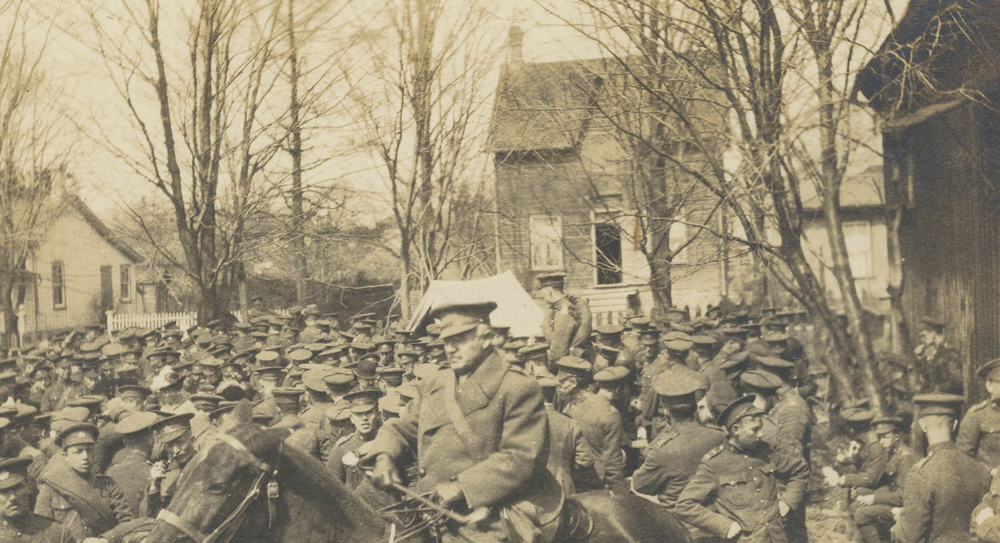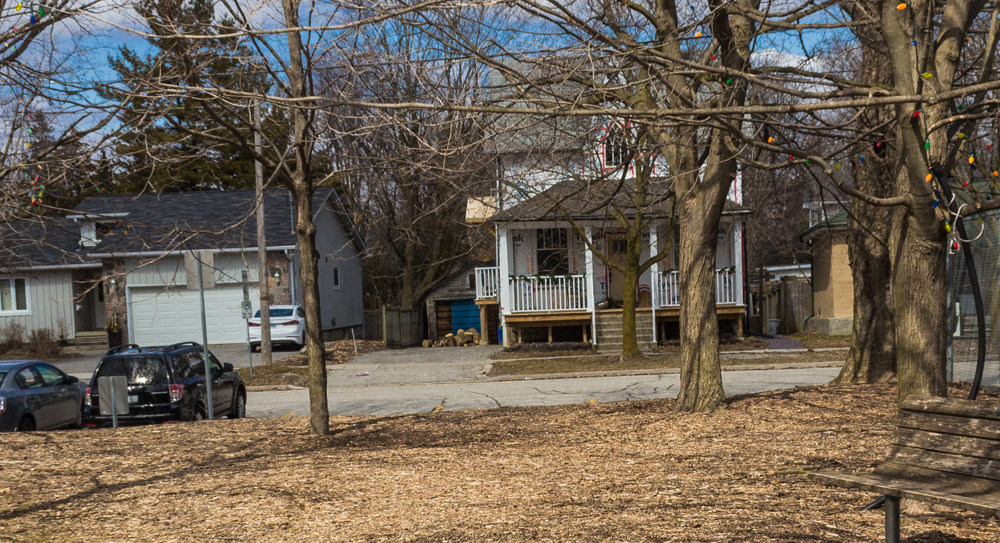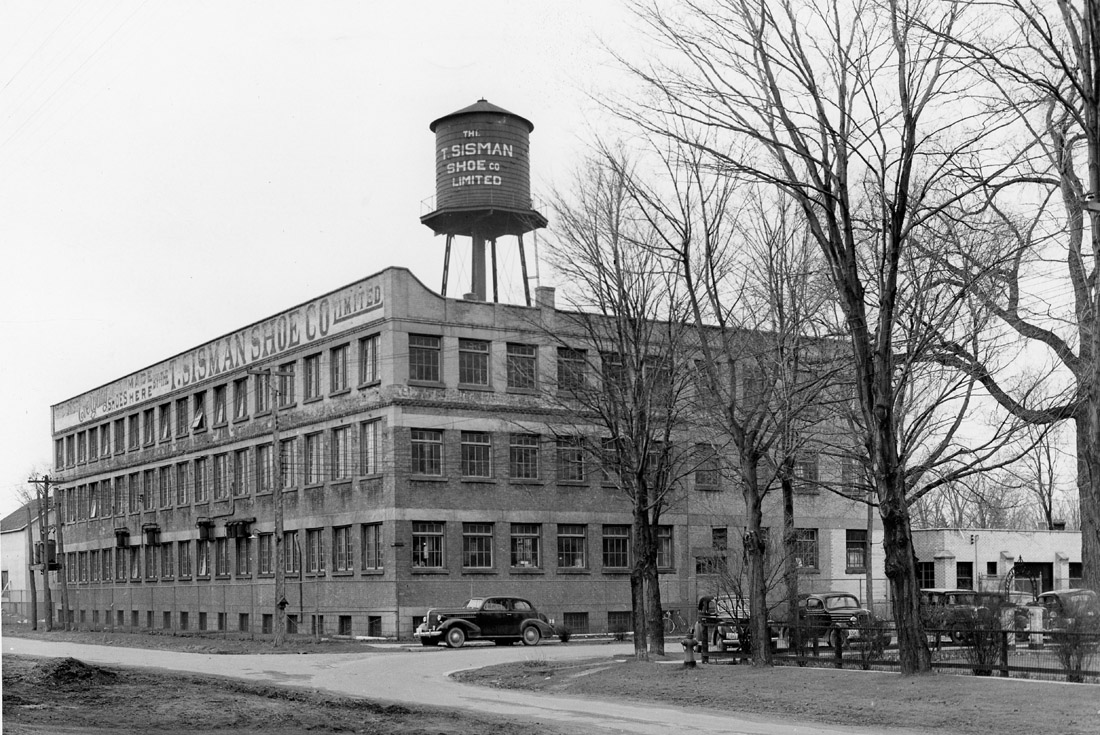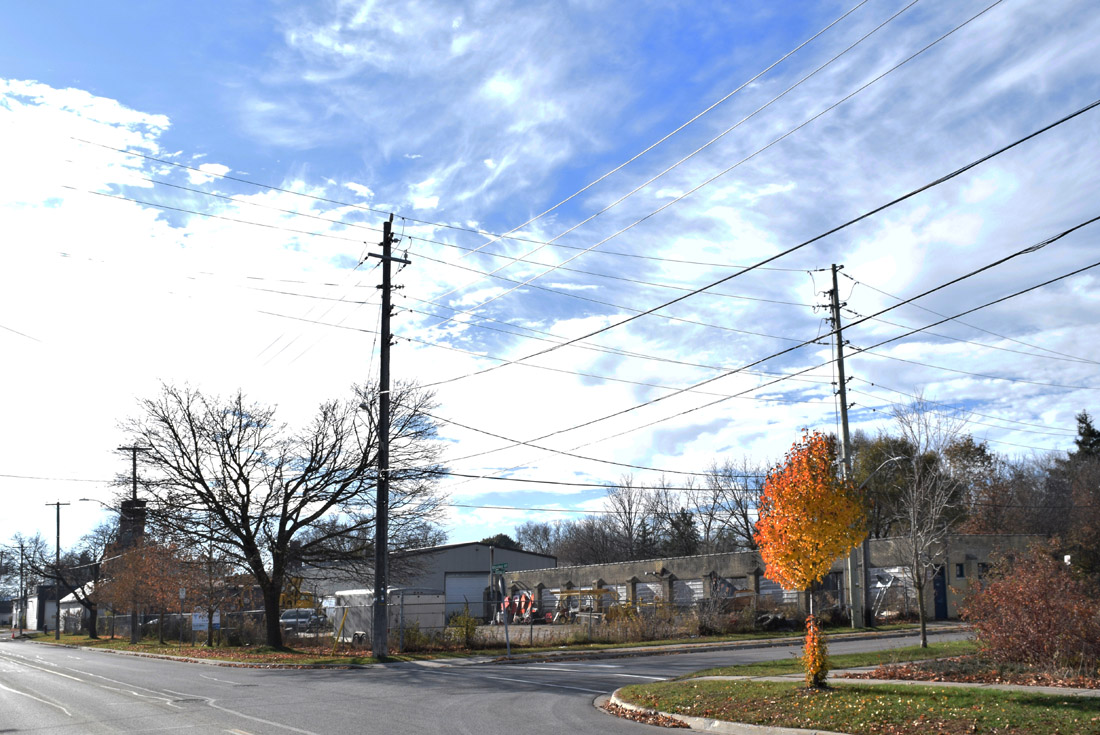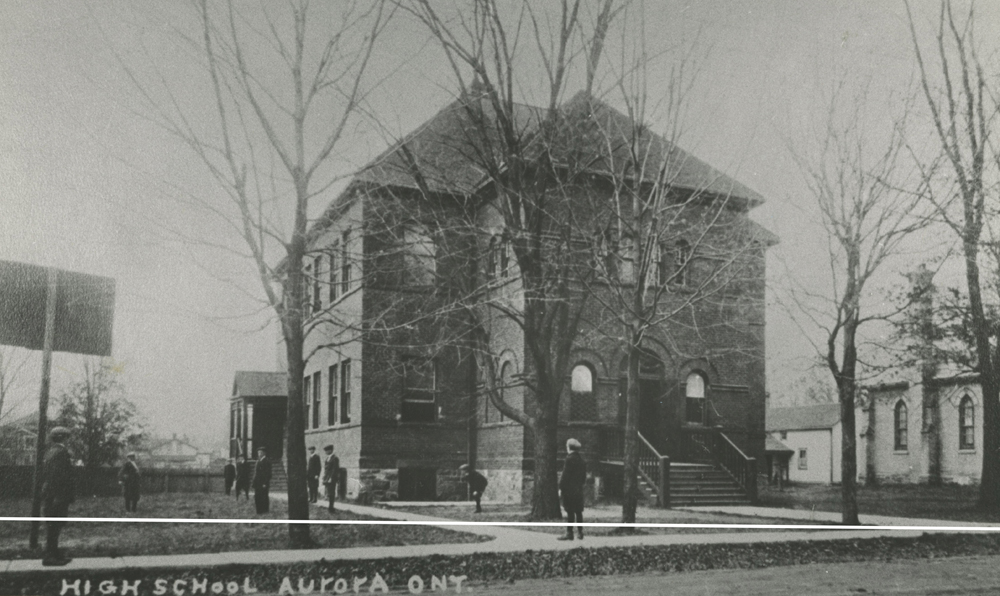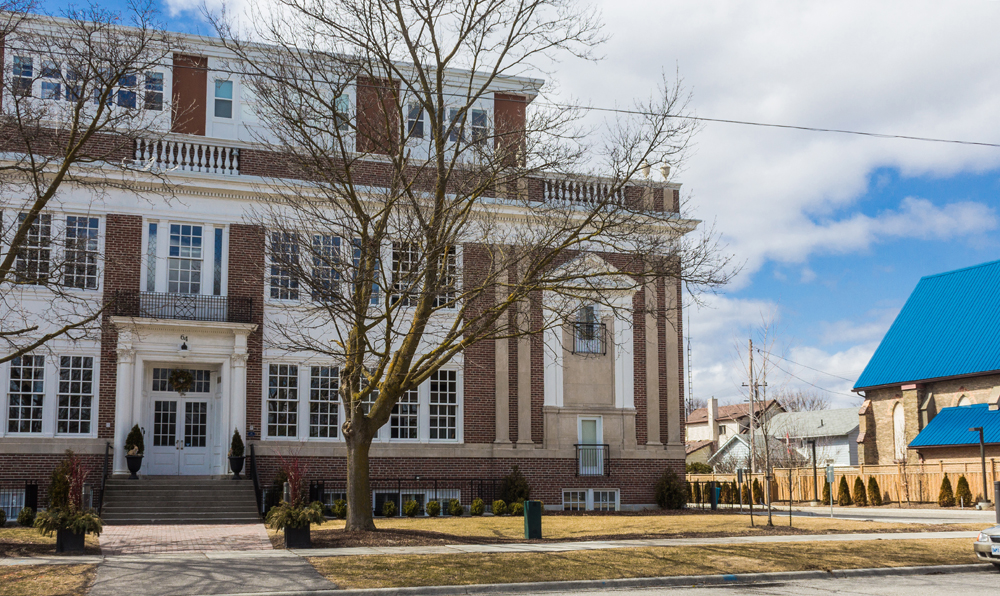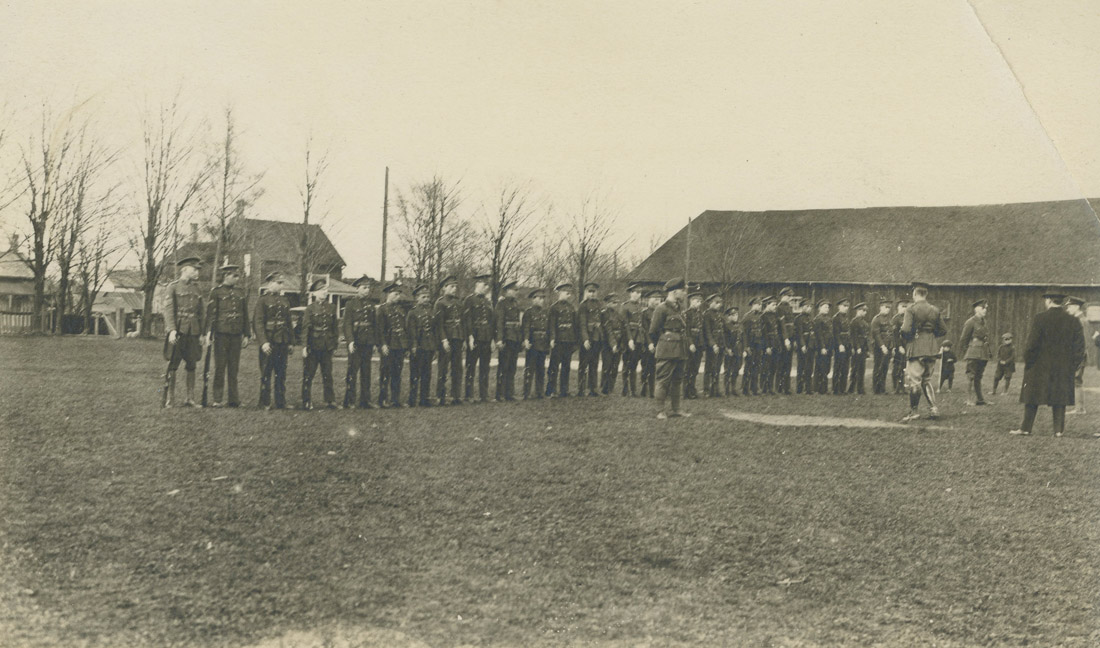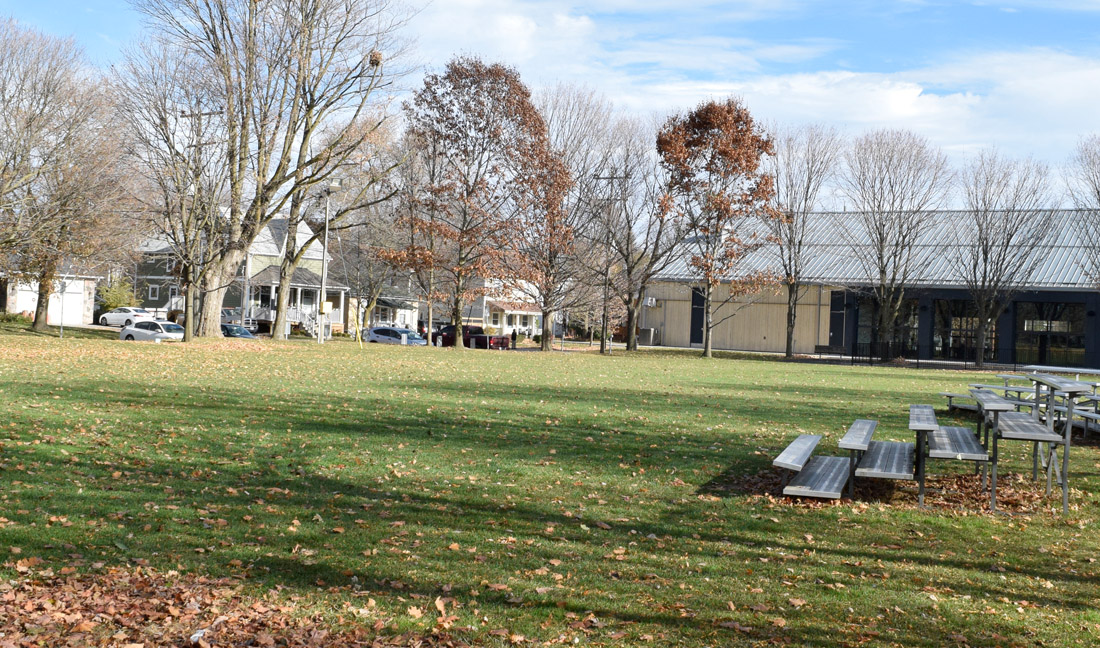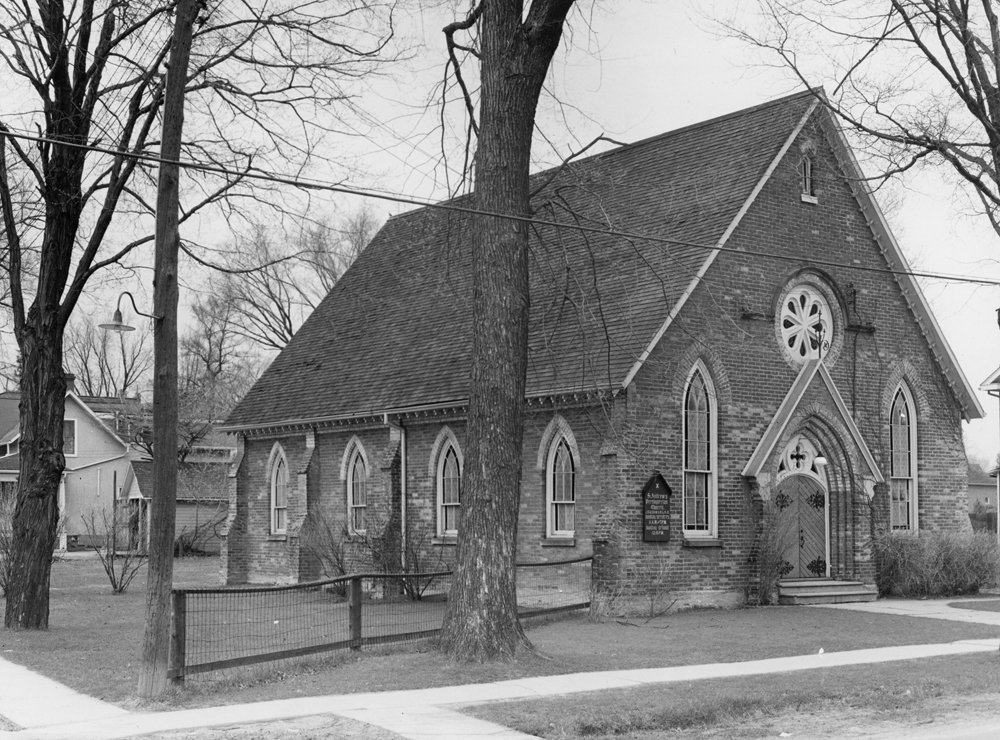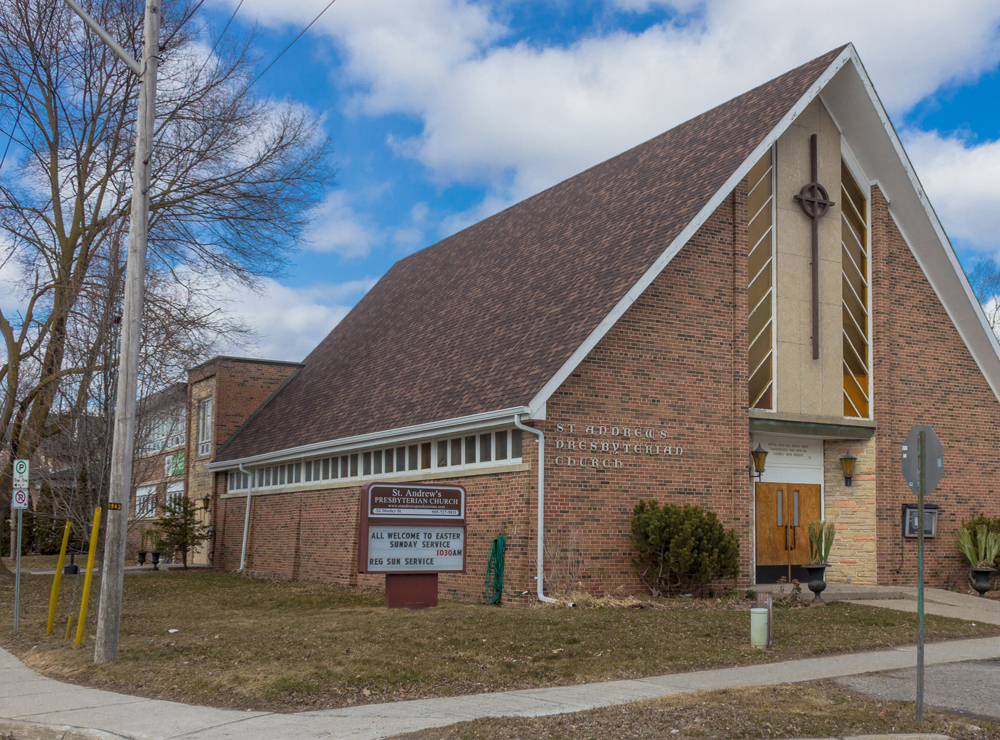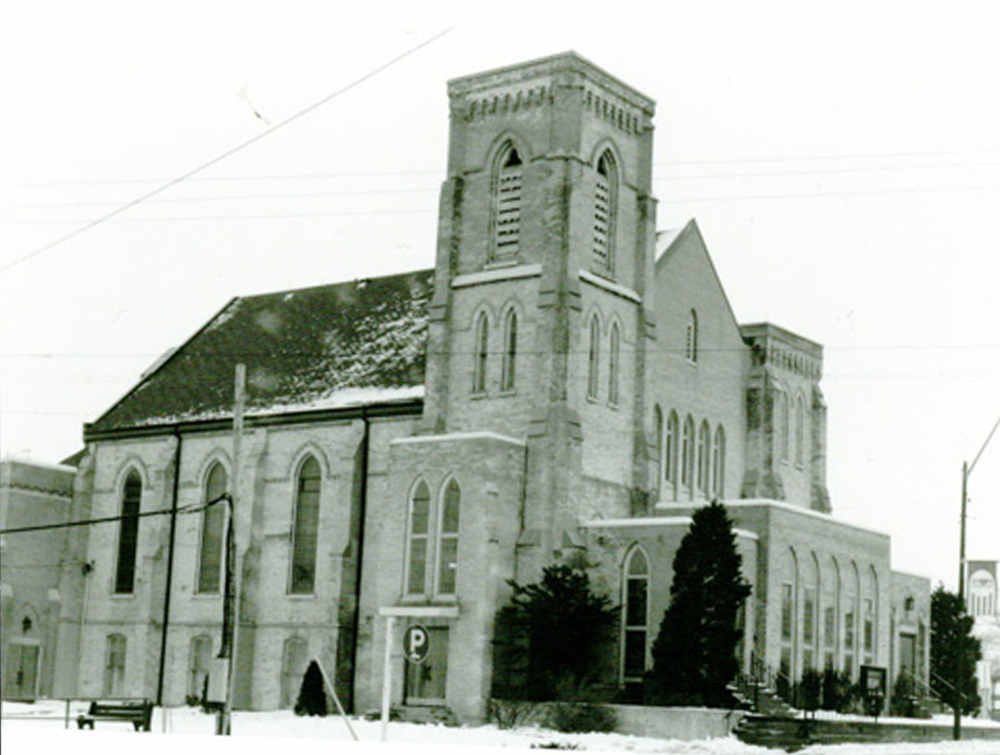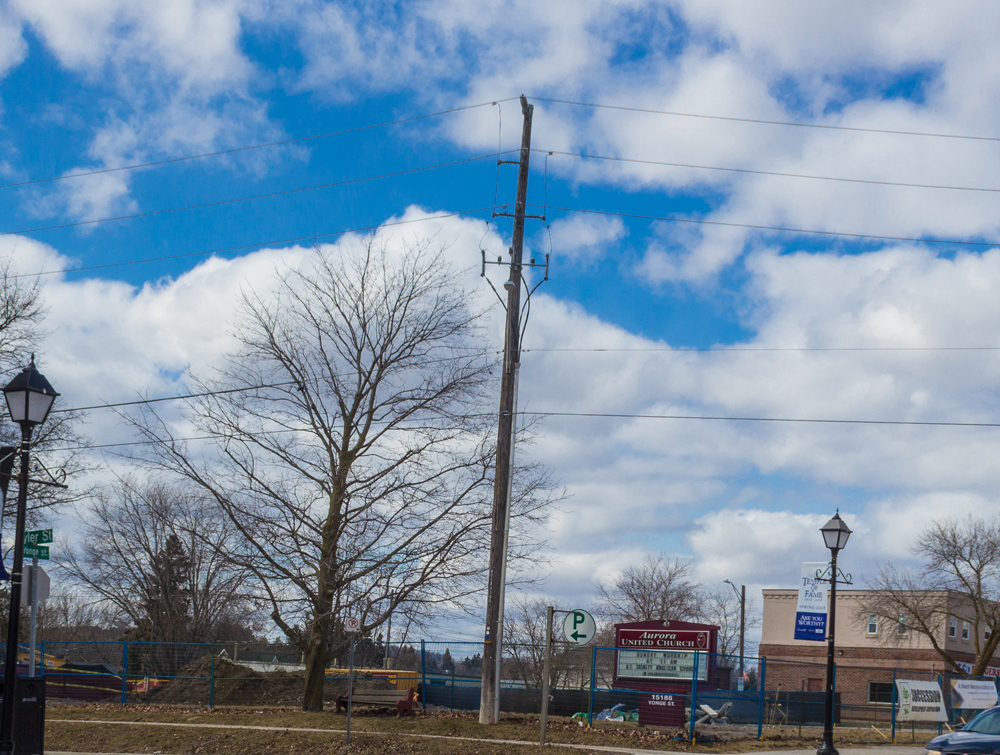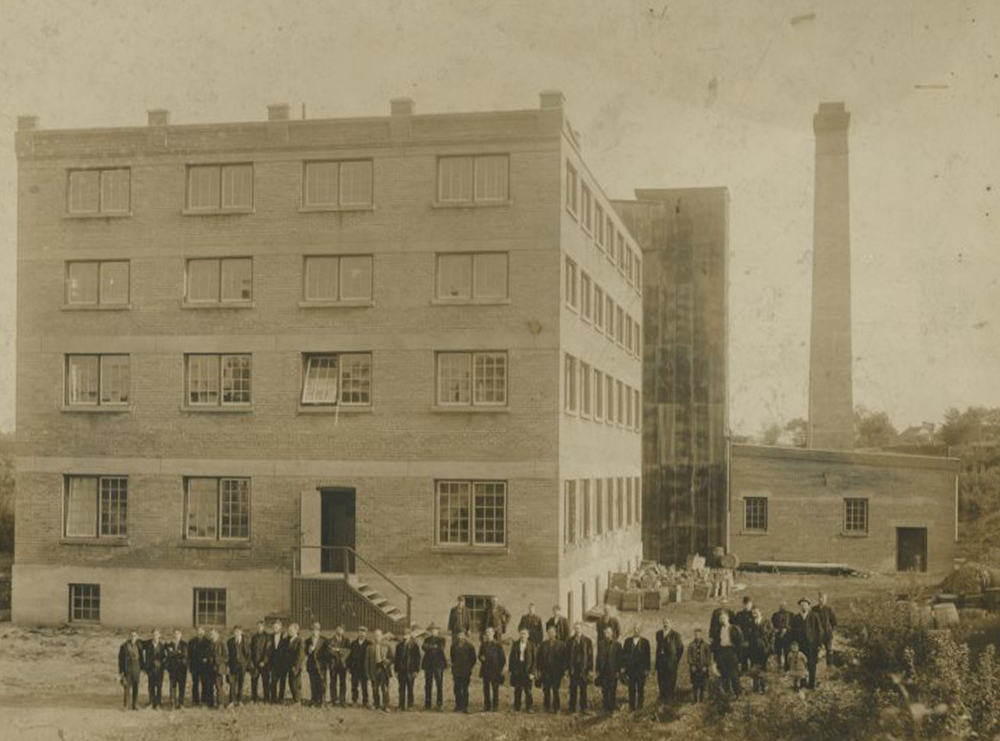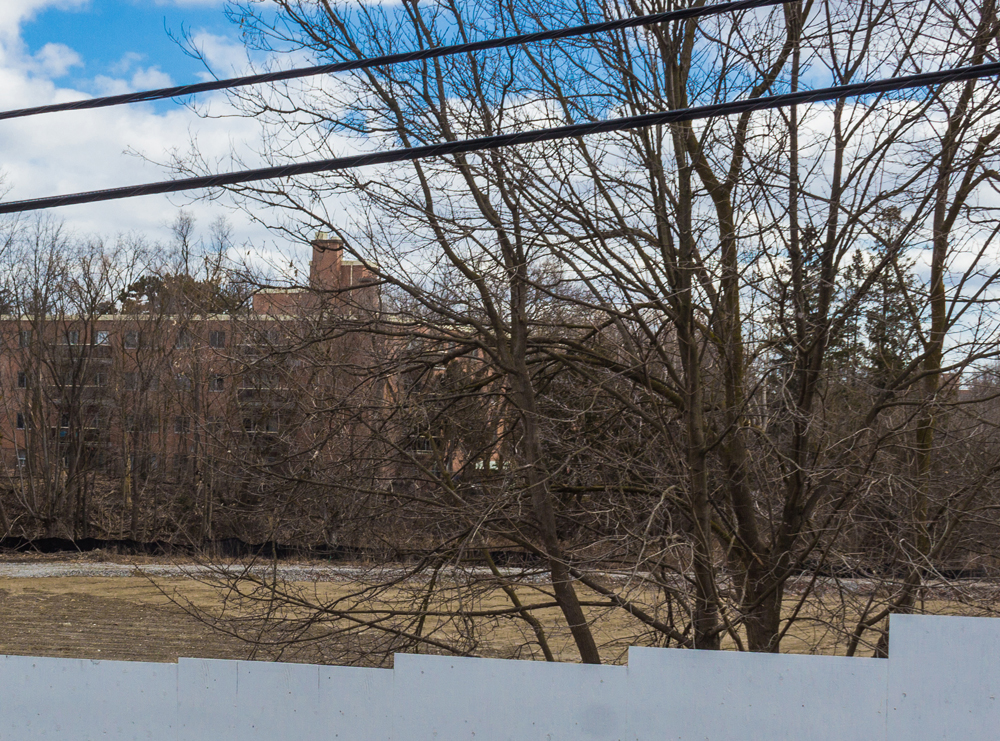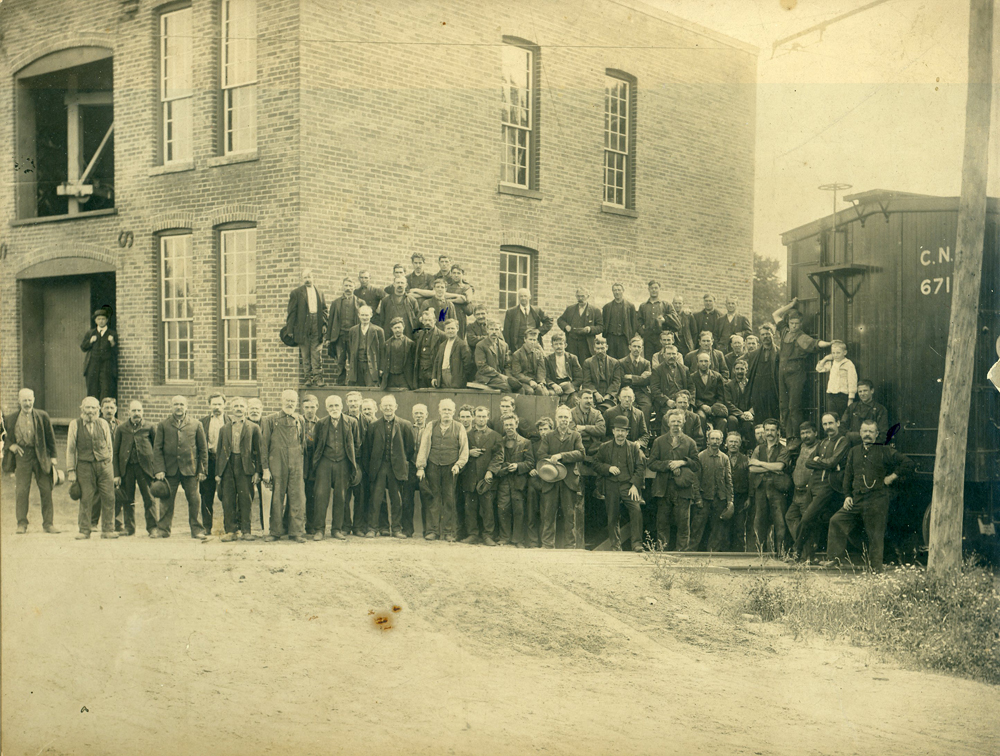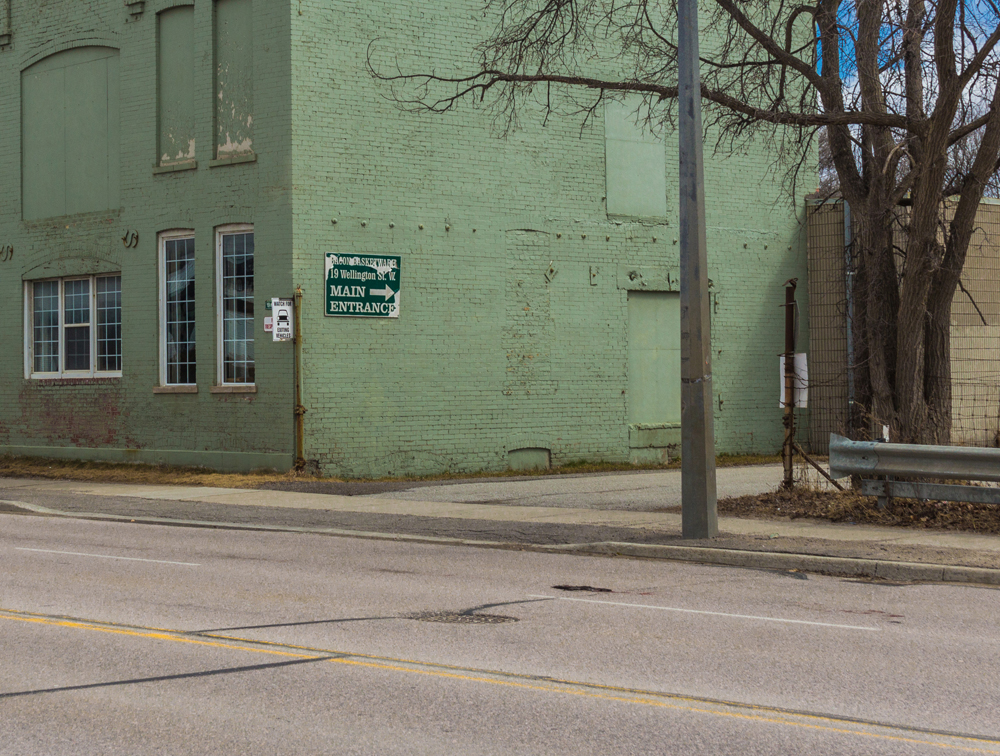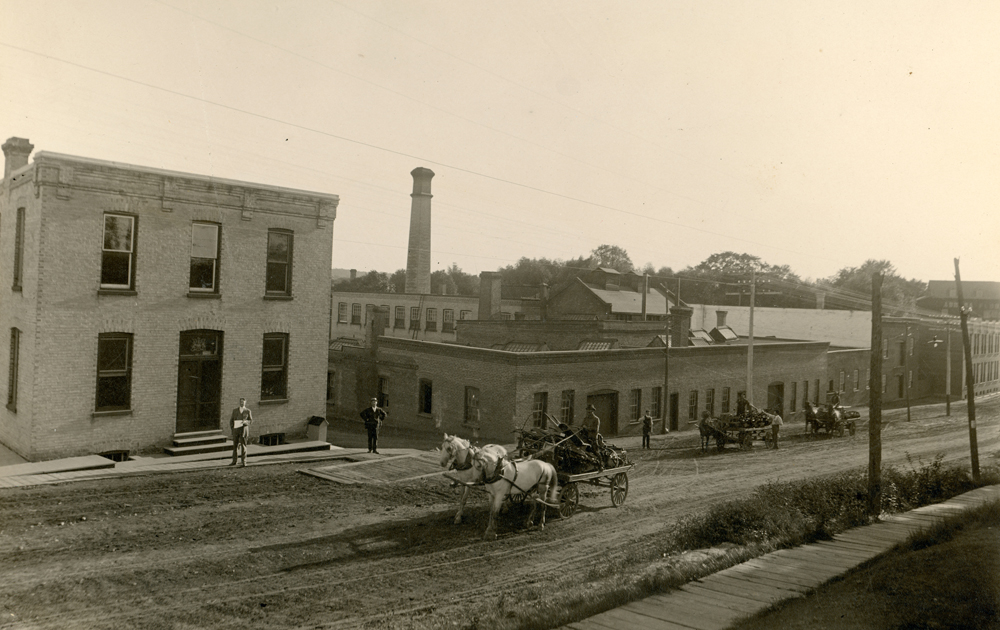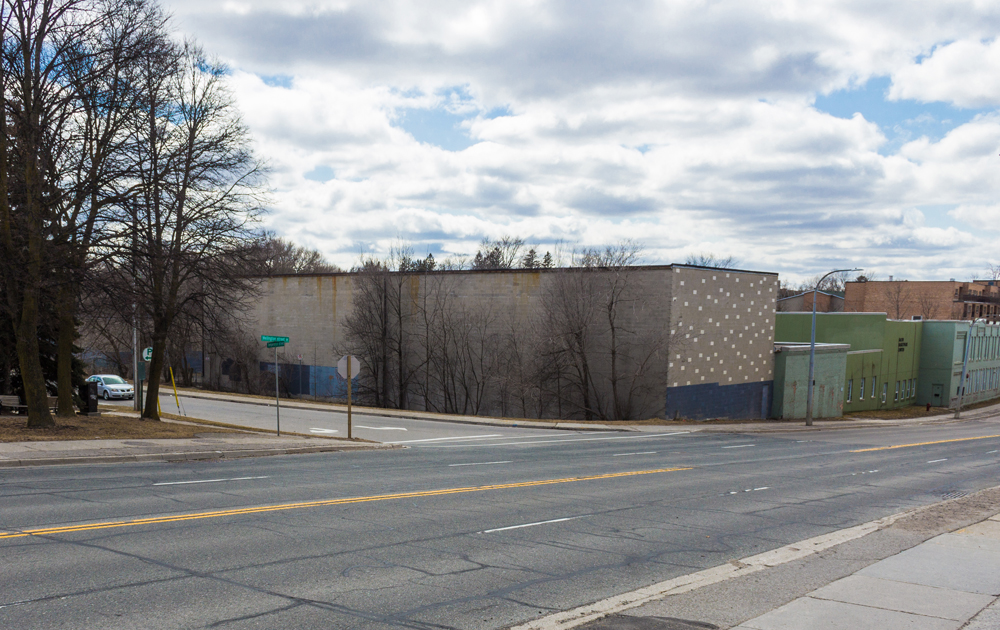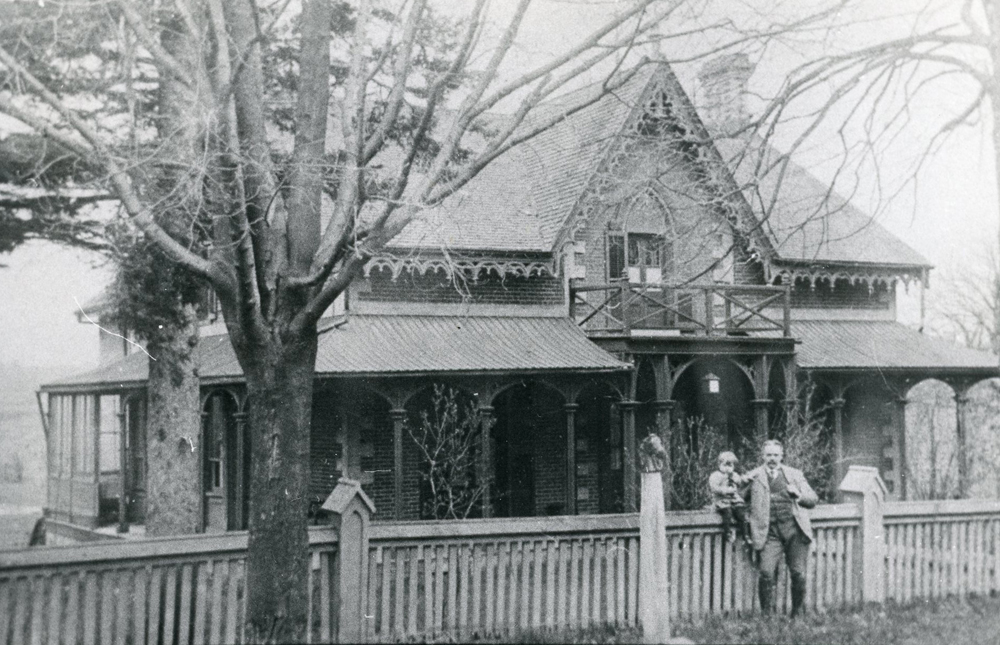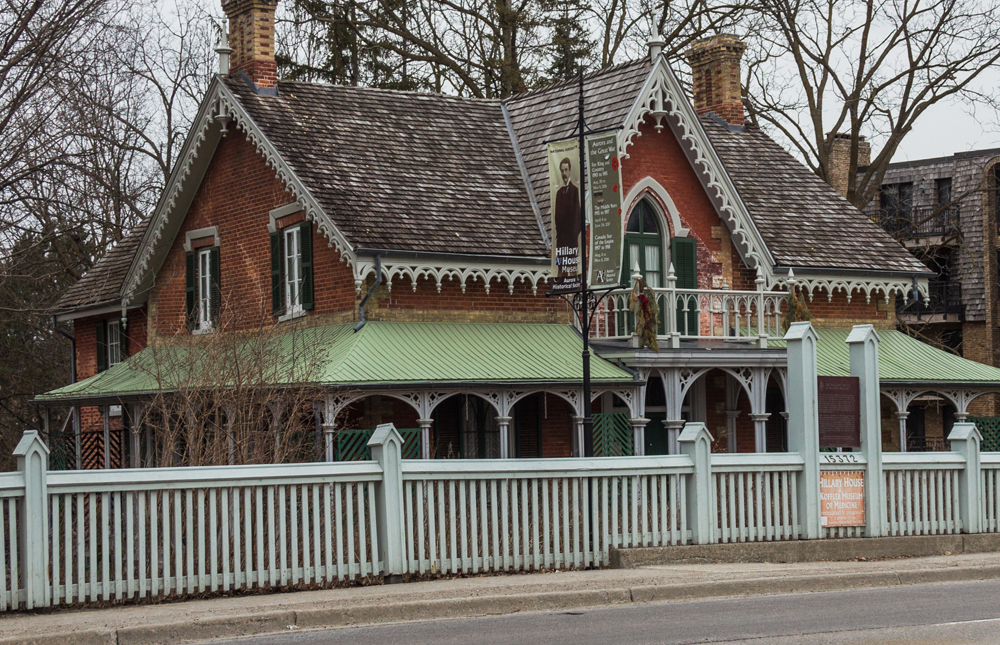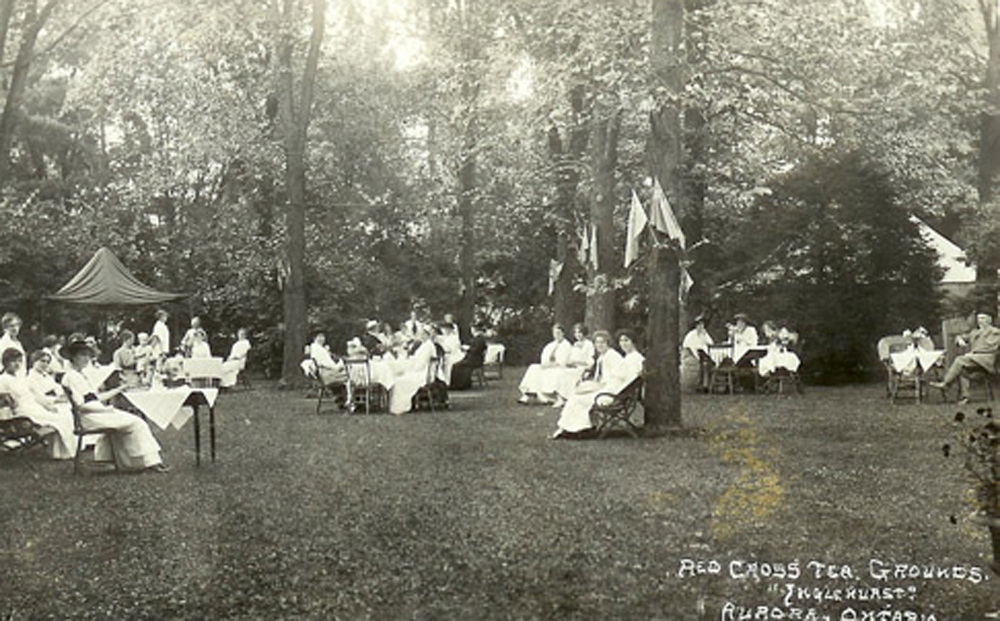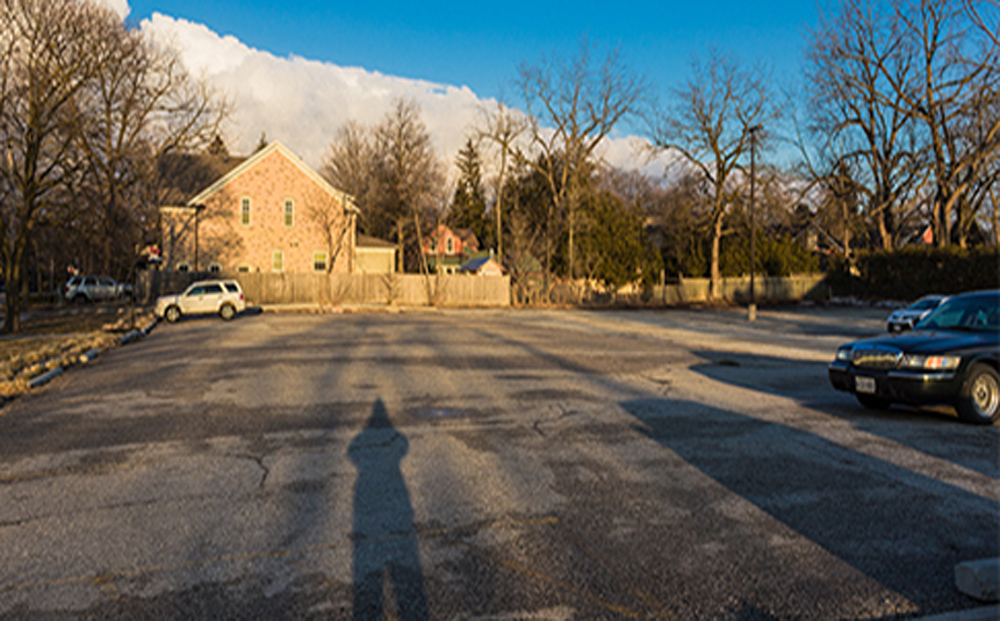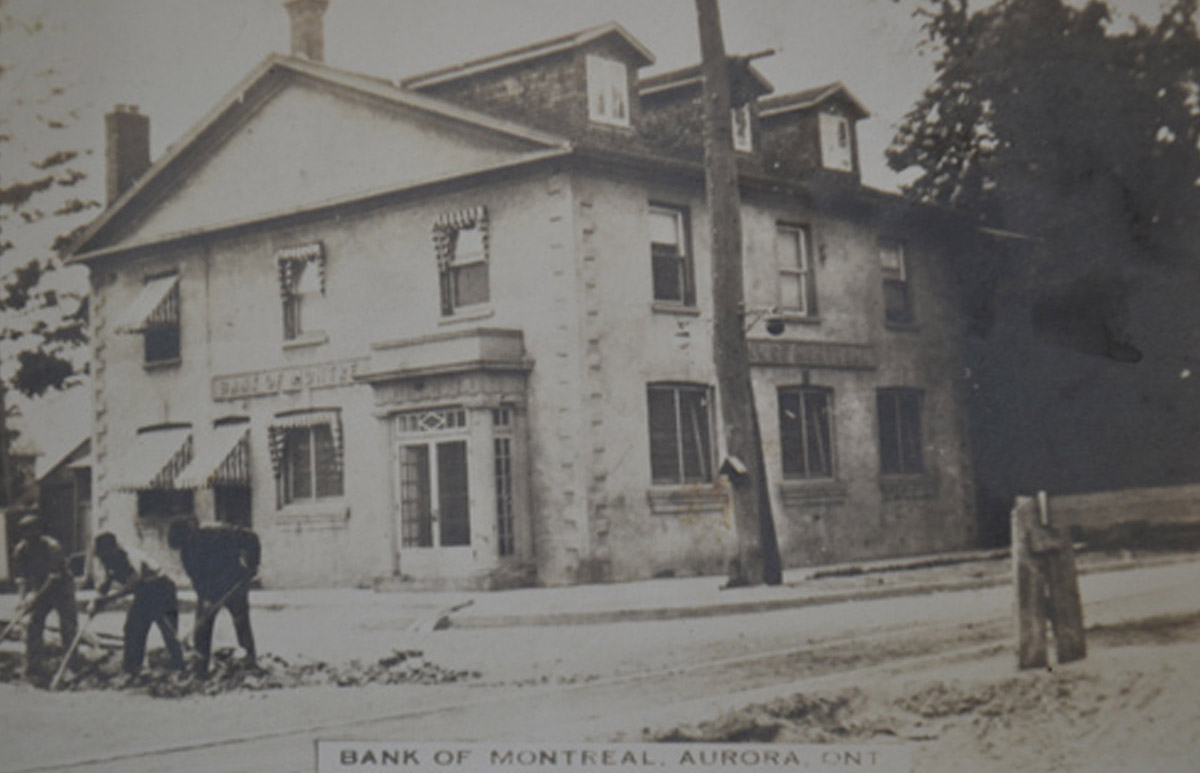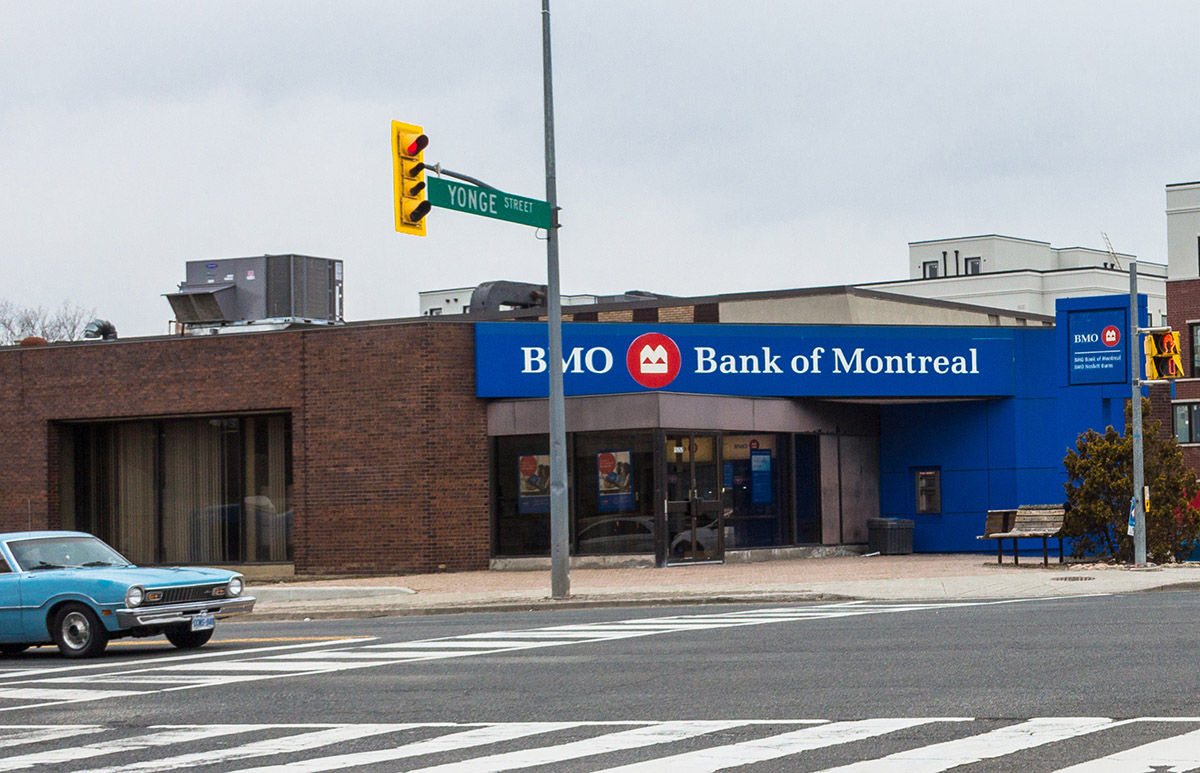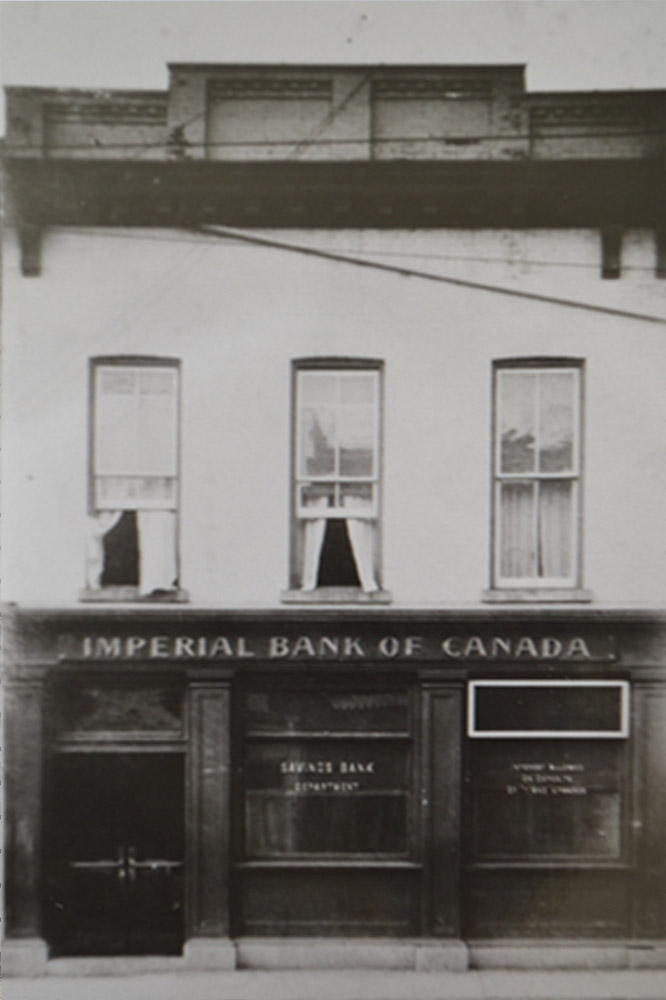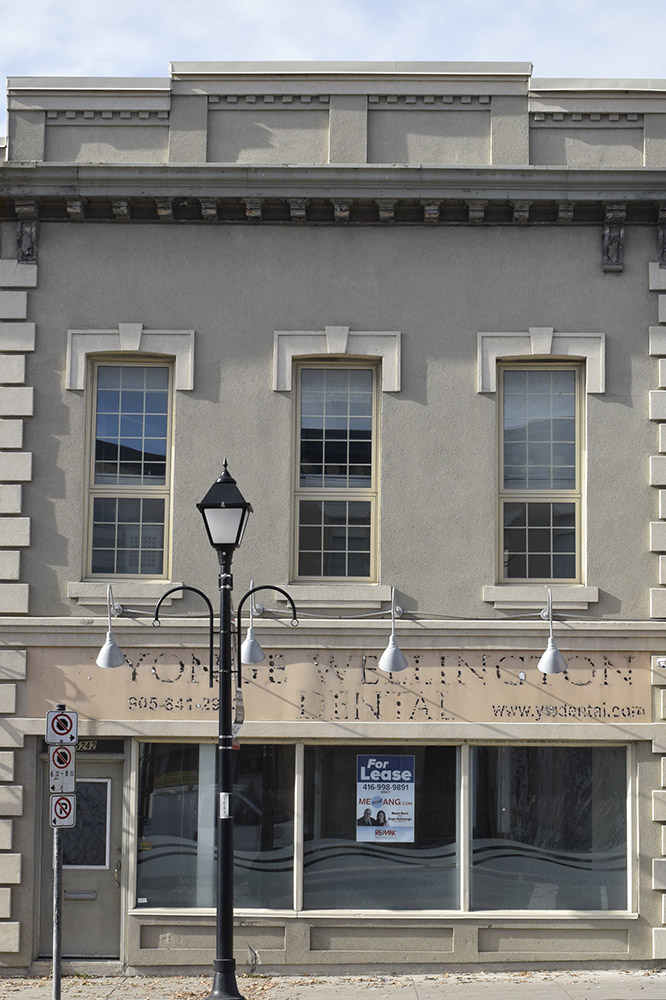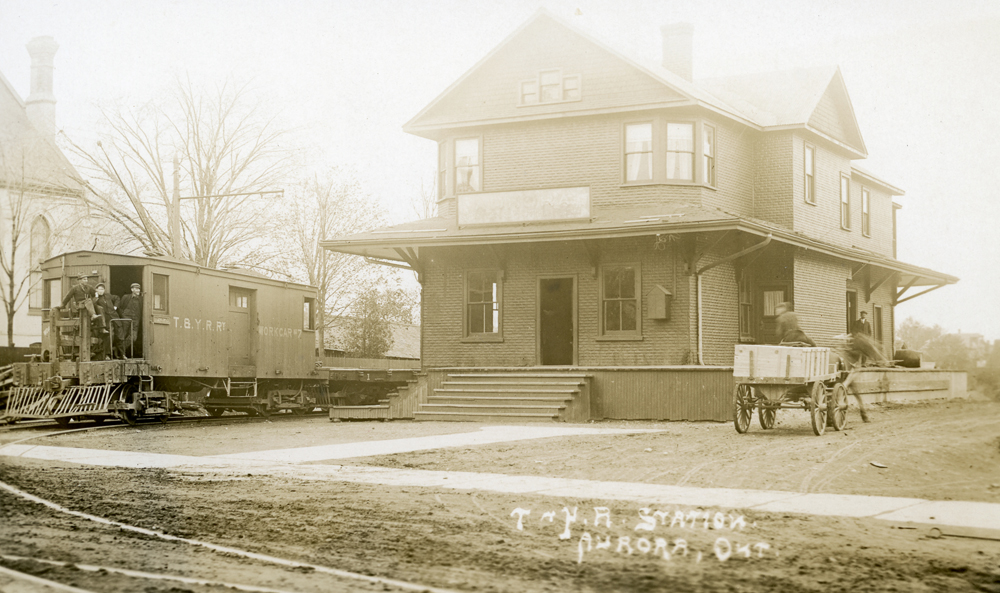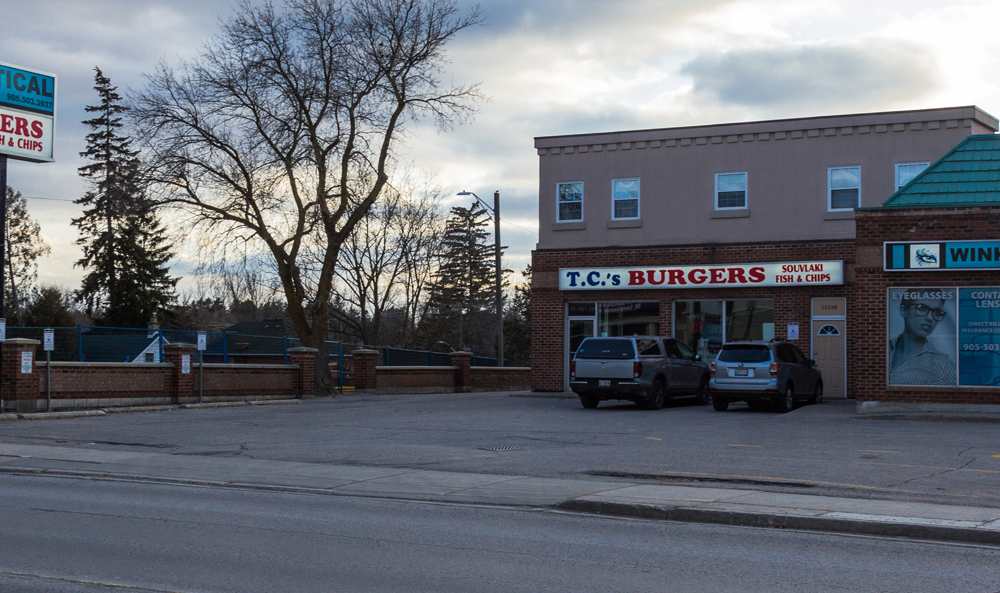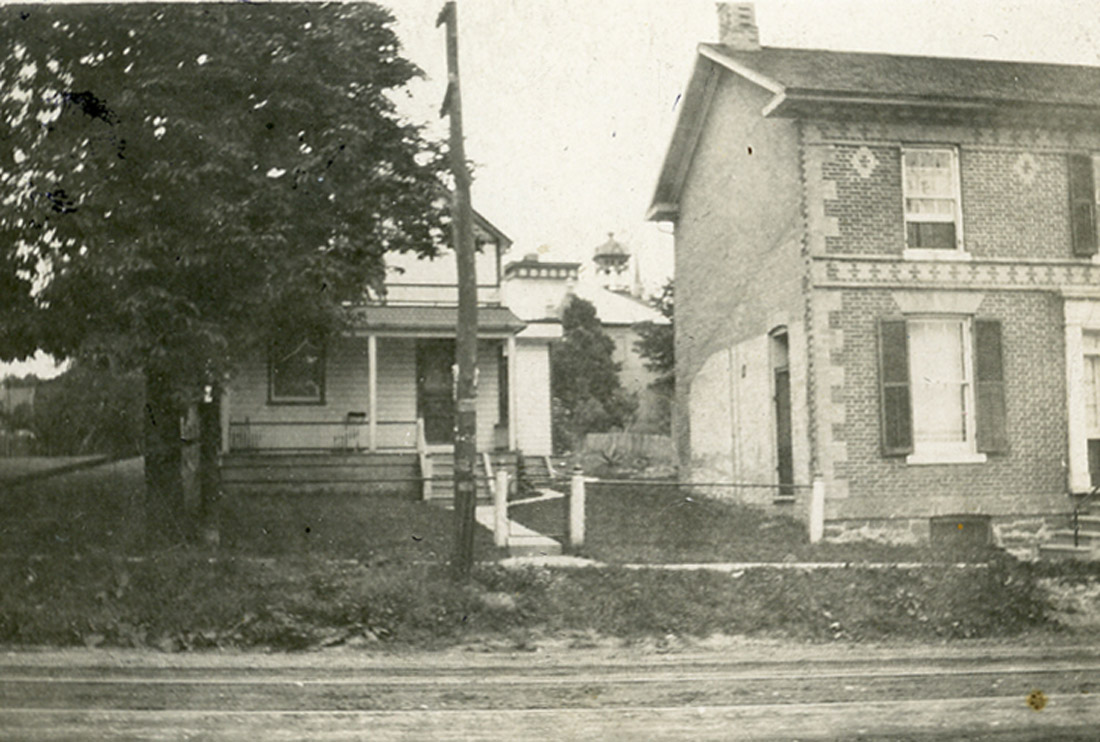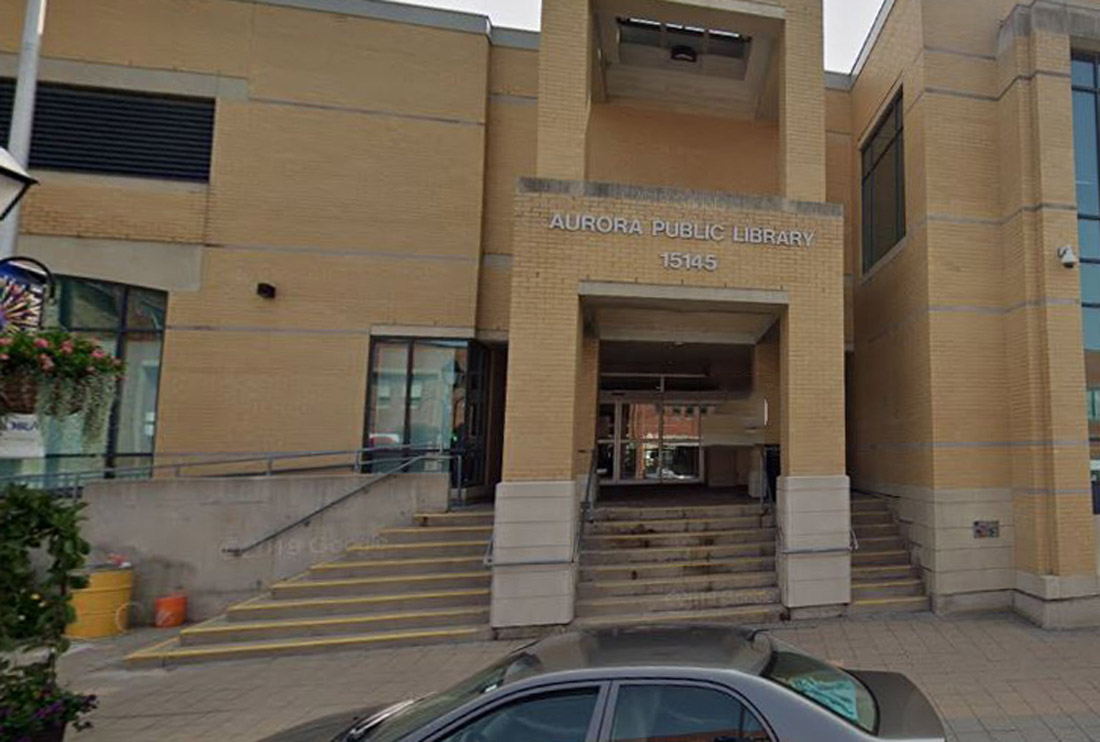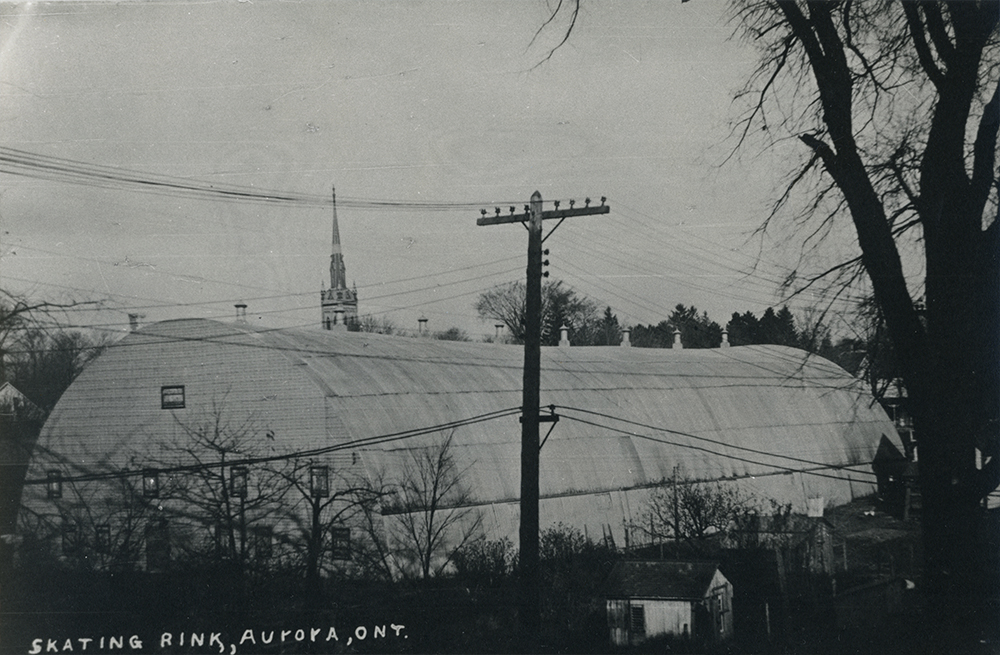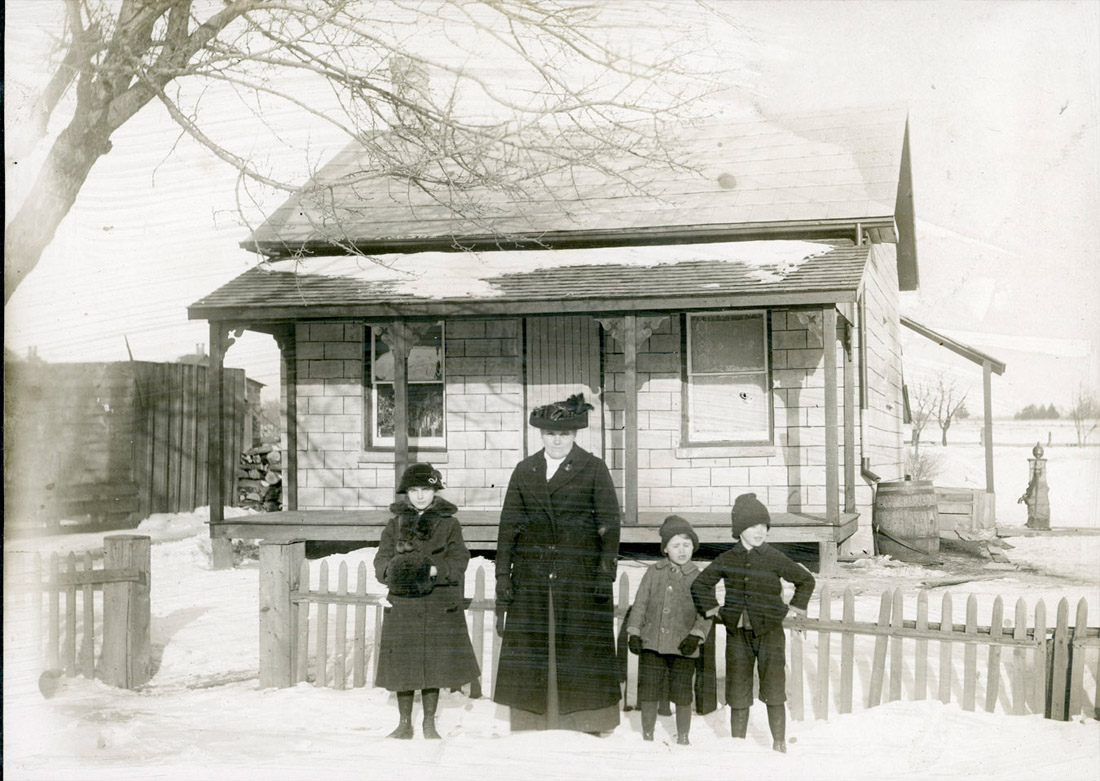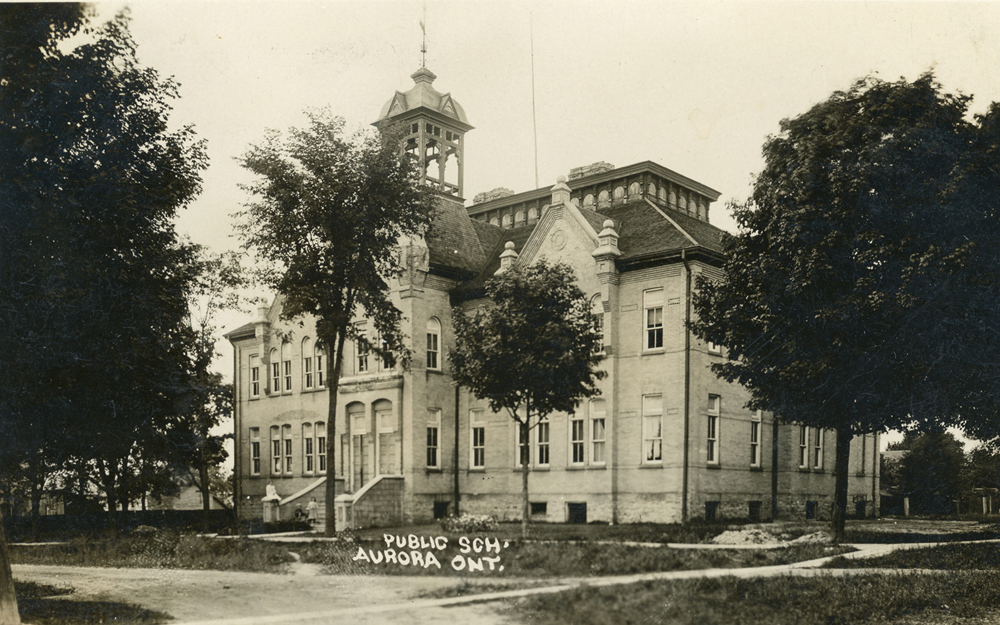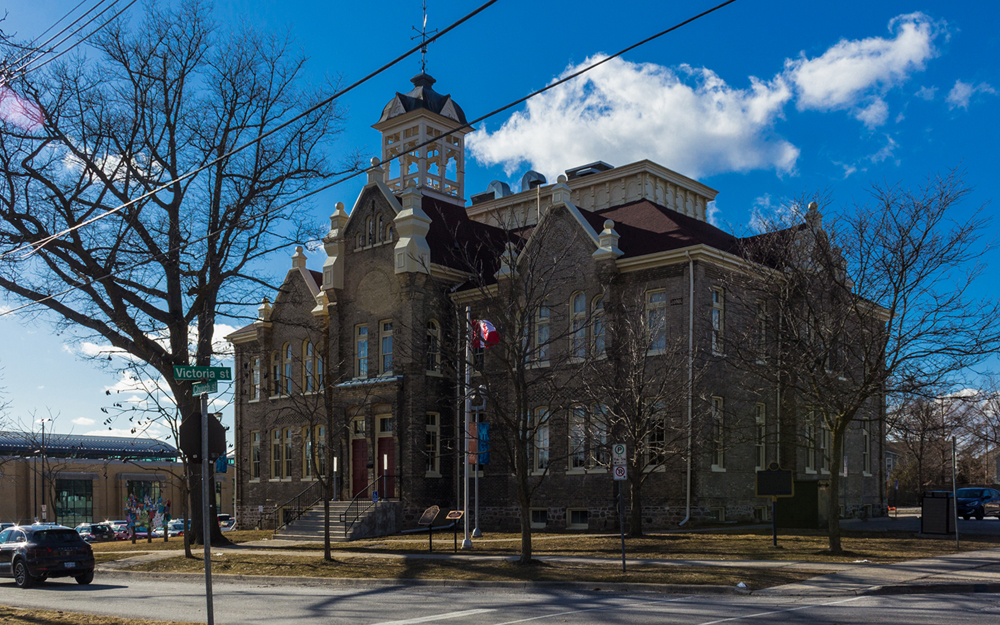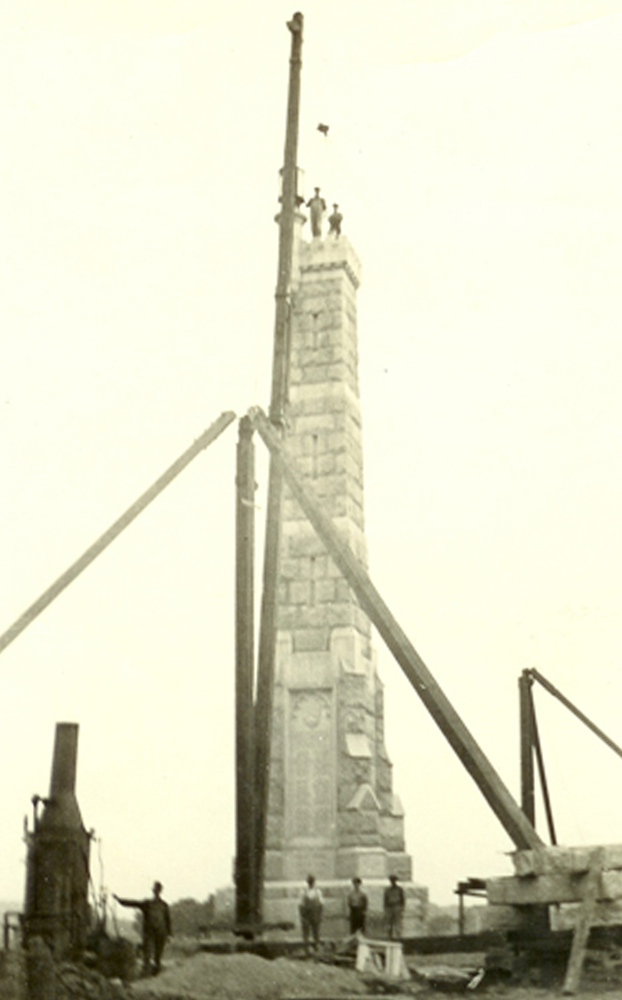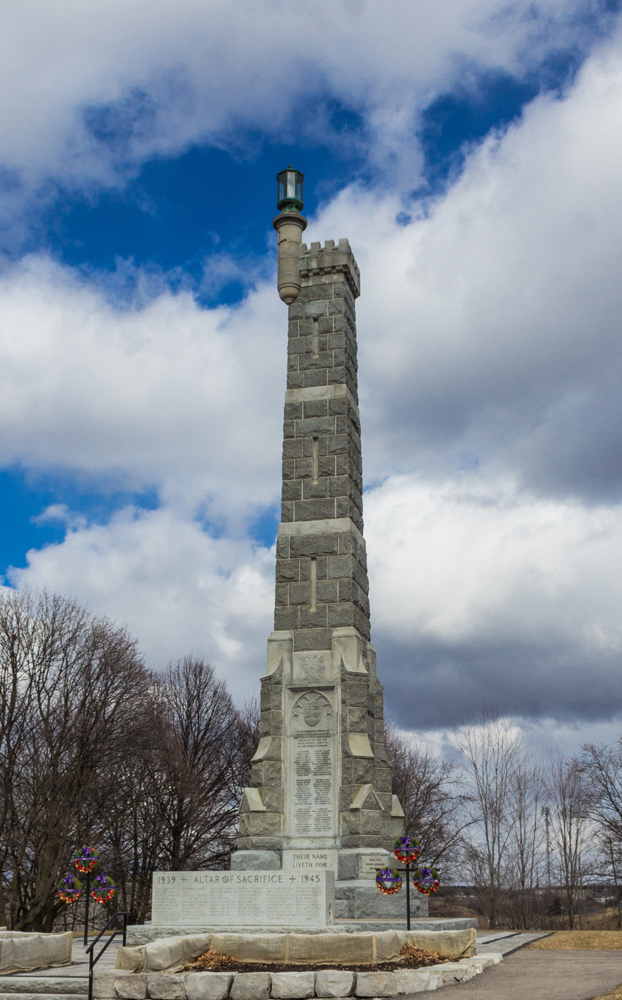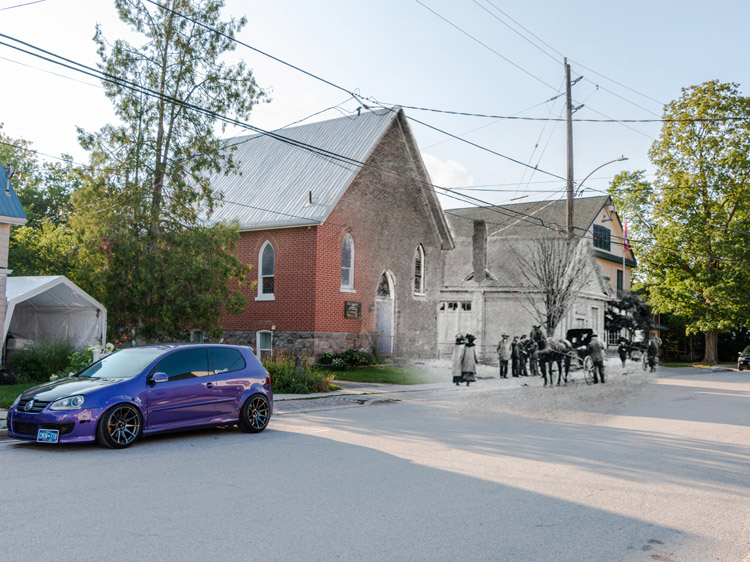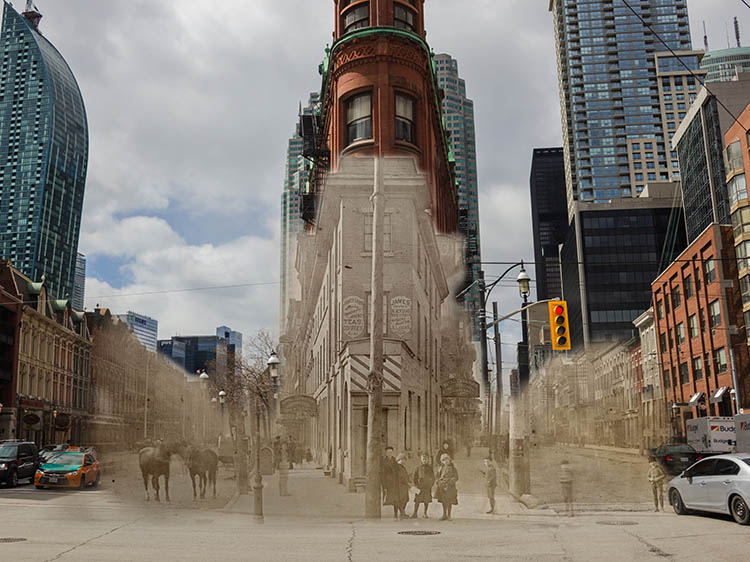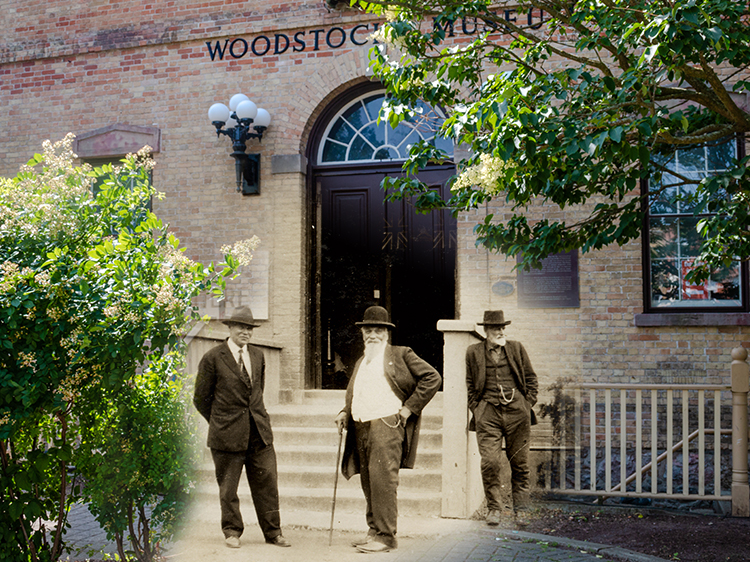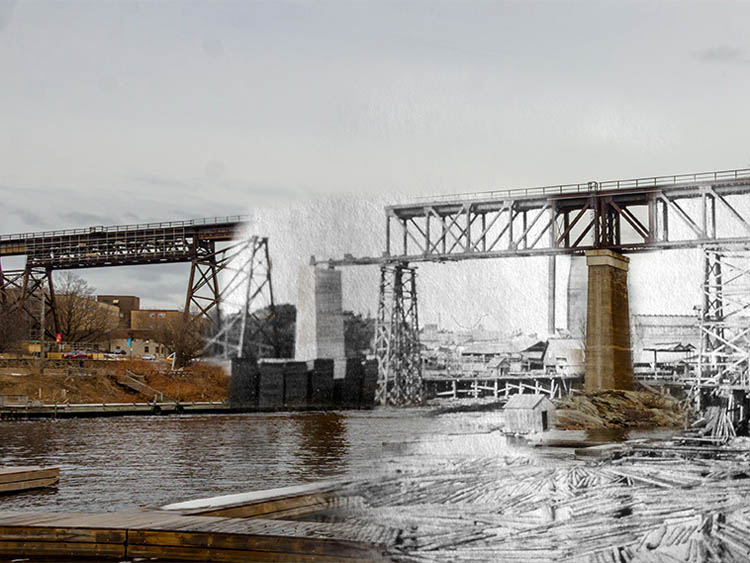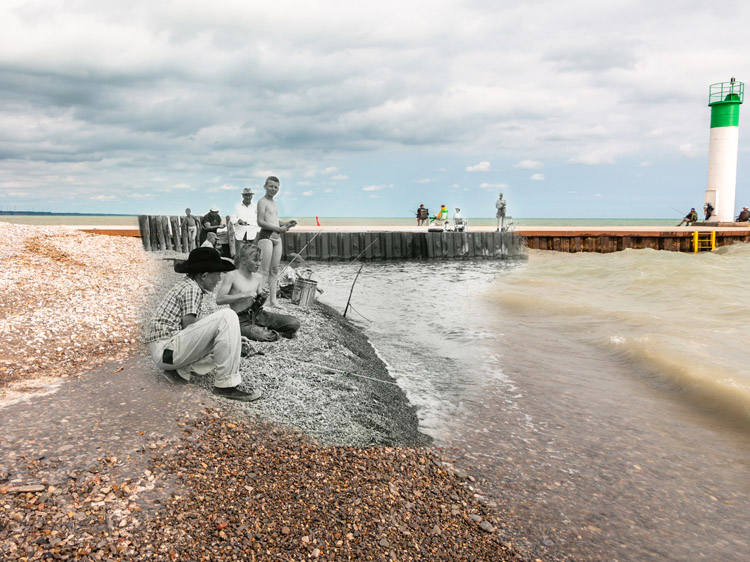Walking Tour
Remembering Aurora's Fallen
Lest We Forget
Tour Contributed by Shawna White, Michelle Johnson, and Jeremy Hood of the Aurora Museum & Archives.
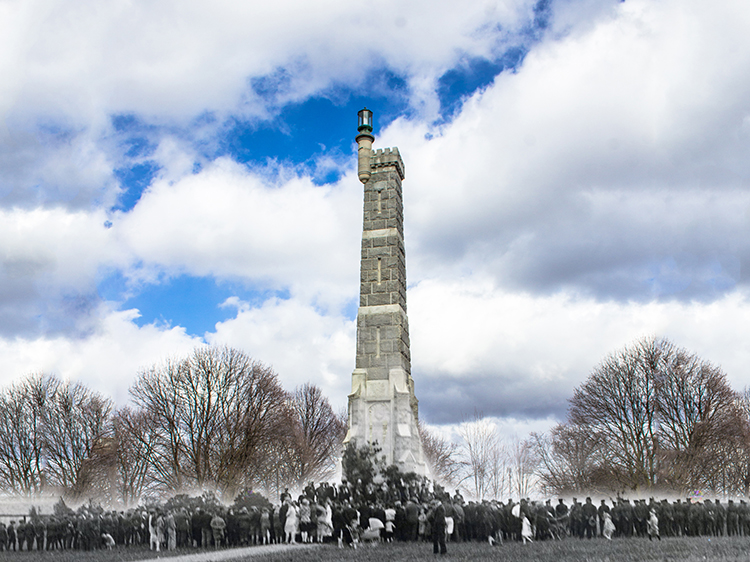
Tour Contributed by Shawna White, Michelle Johnson, and Jeremy Hood of the Aurora Museum & Archives.
On October 3, 1925 a crowd of over three thousand men, women and children gathered together to witness the unveiling and dedication of the Aurora War Memorial. During the First World War, Aurora was truly a small town with a population of approximately 2000. In such a small town, the loss of the twenty-four men who died while serving their country had a searing effect on the community. Some were born here, others were only here a short while. All of their deaths touched the lives of those citizens who were left behind.
After the war, Herbert Fleury (co-owner of J. Fleury’s Sons) acted as an unofficial ambassador from Aurora to the cemeteries in France. In 1921, he toured the Flanders battlefields that were scattered with temporary wooden crosses.
In 1924, the close personal and business relationship between Herbert Fleury and Sir William Mulock provided the impetus for community action – in this case to build a memorial to those who had given their lives. Sir William Mulock purchased the land for a war memorial and offered to contribute $10,000 – but only if citizens from Aurora, King and Whitchurch could raise the same amount. Herbert Fleury’s role, aside from making his own contribution of $1,000, was to chair the Aurora War Memorial Association, which would petition residents of the three municipalities in an attempt to raise the remaining funds. By April 1925, the Association secured the funds and the cornerstone of the memorial was ceremoniously put in place. Construction of the war memorial took just under six months The scene of the unveiling was described by the local paper, “The darkened clouds as if reminiscent of the days of the war parted and the bright sunshine shone through on the bowed heads of 3,000 men and women who had gathered to do honour to the fallen heroes of this section”.1
The Aurora war memorial pre-dates the Canadian National Vimy Memorial (1936) and the Dominion War Memorial (1939).
Engraved on the Aurora War Memorial are the names of 71 soldiers from Aurora, King and Whitchurch. It is here where their sacrifice is remembered. This tour aims to tell their stories, one by one adding to the narrative with ongoing research efforts. We encourage anyone with photographs or stories to share about any of the names contained on the memorial to contact us directly. Lest We Forget.
This project is a partnership with the Aurora Museum & Archives and the Town of Aurora.
1. Private James A Amos
1889 - 1914
Killed In Action at the Battle of Festubert, 23 May 1915.
Age 25.
A mounted officer, Major Robert M. Hillary, stands amongst mustering soldiers in front of the Aurora Armoury in 1915. When the war began James Amos was already a reservist with the 12th York Rangers that was stationed at the Armoury.
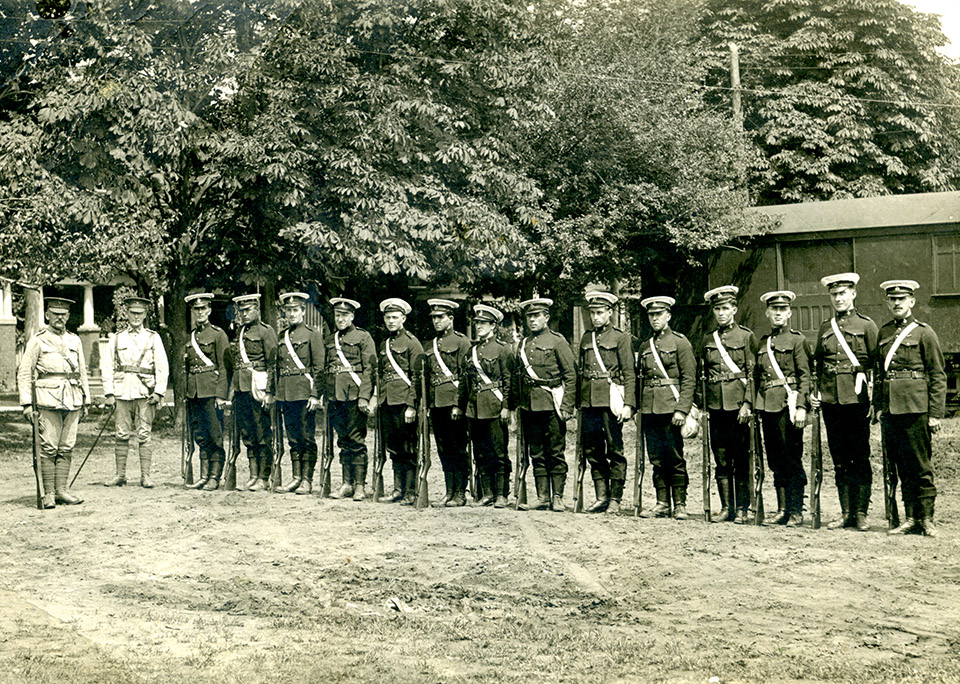
Photo of the 12th York Rangers at Valcartier, Quebec, before shipping out to Europe. Amos is thought to be the fourth from right.
* * *
James was among those individuals eager to join the war shortly after it had been declared, and was part of a group of soldiers who were enthusiastically sent off to Long Branch for training by a large crowd at the Aurora station on August 17, 1914. The group travelled to Valcartier, Quebec, where James enlisted as a Private with the 4th Infantry Battalion, C.E.F. on September 22, 1914. Embarking the next day, James’ unit remained aboard the S.S. Tyrolia until they sailed October 3rd to Liverpool, and spent the winter training in England.
James was assigned as a Stretcher Bearer to the Headquarters in Rouen, France in February, and arrived at the front lines on March 1, 1915. In early May, he became ill with influenza and was treated at the No. 2 Canadian Field Ambulance, but was able to return to the front lines. His unit saw action at the Second Battle of Ypres, and was present at the battle of Festubert, where unfortunately, Private James Amos was killed in action on May 23, 1915. He was 25 years old.
James is buried at the Guards Cemetery at Cuinchy. News of his death reached Aurora through a letter published in the Aurora Banner that had been written by fellow soldier William Henry Marment, one of the soldiers that left Aurora with James. Sadly Marment himself would die later in the war.

Read More: 4th Battalion
Battle of Festubert
2. Corporal Heber L. Higgs
1885 - 1917
Died of Wounds received at the Battle of Passchendaele, 20 Dec. 1917.
Age 32.
Heber Higgs was born in Leicester, England in 1885 to Heber Higgs and Harriet Watson. At the outbreak of the war, he was living in Aurora with his wife Emma Elizabeth Race and son Allen Edward, and was working at T. Sisman Shoe Co, pictured here. Before emigrating to Canada in September 1913, Heber had served with the Royal Navy in England enlisting when he was 18 years old.
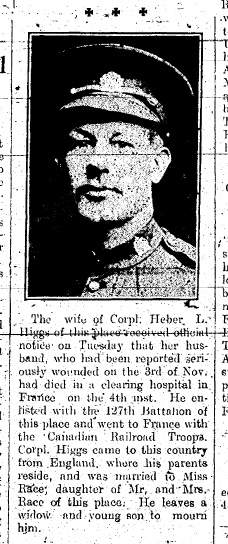
* * *
At Witley, England, Heber was transferred to the 1st Construction Battalion, rather than remaining with the 127th. One week thereafter, he left for France with his unit, and on February 1, 1917, he was promoted to Acting Lance Corporal. The next week, February 9, his battalion was renamed the 1st Canadian Railway Troops, and was tasked with the construction and maintenance of several grades of track across the battle zone. On November 3, 1917, Heber was with a work party in the Vleteren region of Belgium when a German shell exploded, wounding him and many others, and killing seven men outright.
He was transported to the No. 61 Casualty Clearing Station in Lozinghem listed as “Dangerously Wounded” in the abdomen and legs. Heber was able to communicate and spoke with his brother-in-law, Private Tom Adkins, who was married to his wife’s other sister Hannah Jane, and was working at a nearby Casualty Clearing Centre (Aurora Banner, November 30, 1917). Heber died the next day. He was 32 years old.
Heber was buried at the nearby Dozinghem Military Cemetery in Belgium. Back in Aurora, a memorial service was held for Heber on Sunday, November 25, 1917 at Trinity Anglican Church. No doubt Walter Harris’ widow Amy was in attendance to mourn alongside her sister. After the war in 1919, Emma Higgs and Amy Harris would travel together to England with their two young sons; both were listed in the ship passenger lists as living on Machell Avenue.
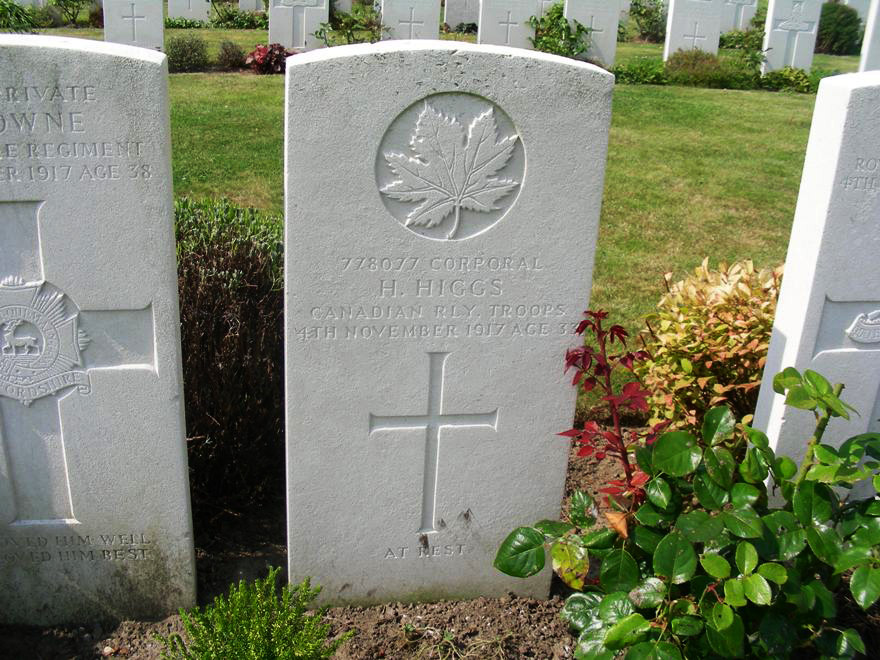
Read More:
The Battle of Passchendaele: https://thecanadianencyclopedia.ca/en/article/battle-of-passchendaele
3. Private Herman Clifton Brown
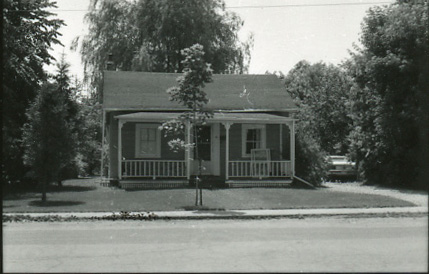
1893 - 1918
Died of medical complications at hospital in Toronto, 4 April 1918.
Age 25.
This was the home of brothers Herman and Stanley Brown, who both tragically died in the war. Herman was with the first Canadian contingent to be sent overseas, but his war would be a short one.
* * *
Herman’s unit sailed aboard the S.S. Megantic with the entire First Contingent on October 3rd, and spent the Winter training in England. On March 14, 1915, shortly after arriving in France, Herman suffered a gunshot wound to the left foot and complained of some deafness. He was transferred back to England and admitted to the large hospital at Netley, England. He would not return to the front lines, being afflicted with a number of ailments and remained in England receiving treatments until 1918.
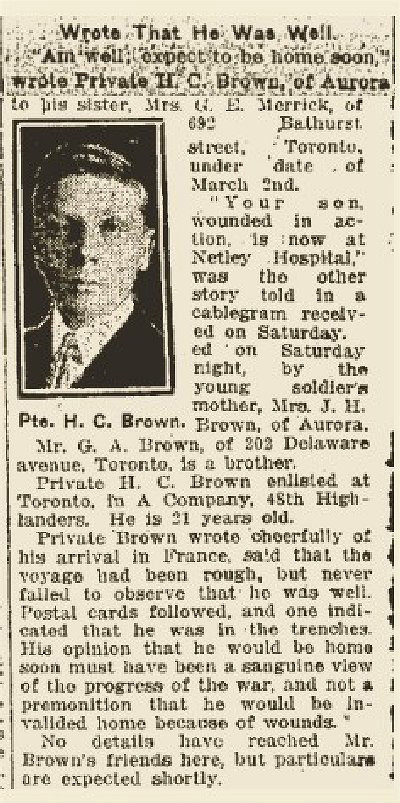
During this time, he was transferred to the 17th Reserve Battalion, as he was no longer counted on active duty with the 15th Infantry. Herman was invalidated back to Canada as a possible Tuberculosis case in February of 1918. Once back in Toronto, he continued to suffer from the trauma of the war. Herman was frequently treated at the Spadina Military Hospital in Toronto where he died of heart failure after suffering a bout of dementia and hallucinations on April 4, 1918. He was 25 years old.
Herman’s funeral was held at his parent’s home in Aurora where full military honours were paid. The funeral was attended by the Town Council, the Public School Trustees, and members of the 12th York Rangers. All businesses in Town were closed for two hours as a sign of respect. Herman is buried in the Aurora Cemetery.
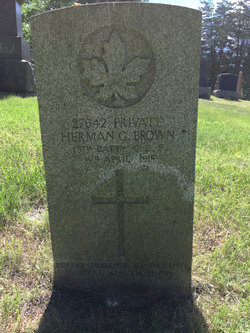
Read More:
15th CEF Battalion (48th Highlanders of Canada): http://15thbattalioncef.ca/regimental-history/
4. Private Stanley Gordon Brown
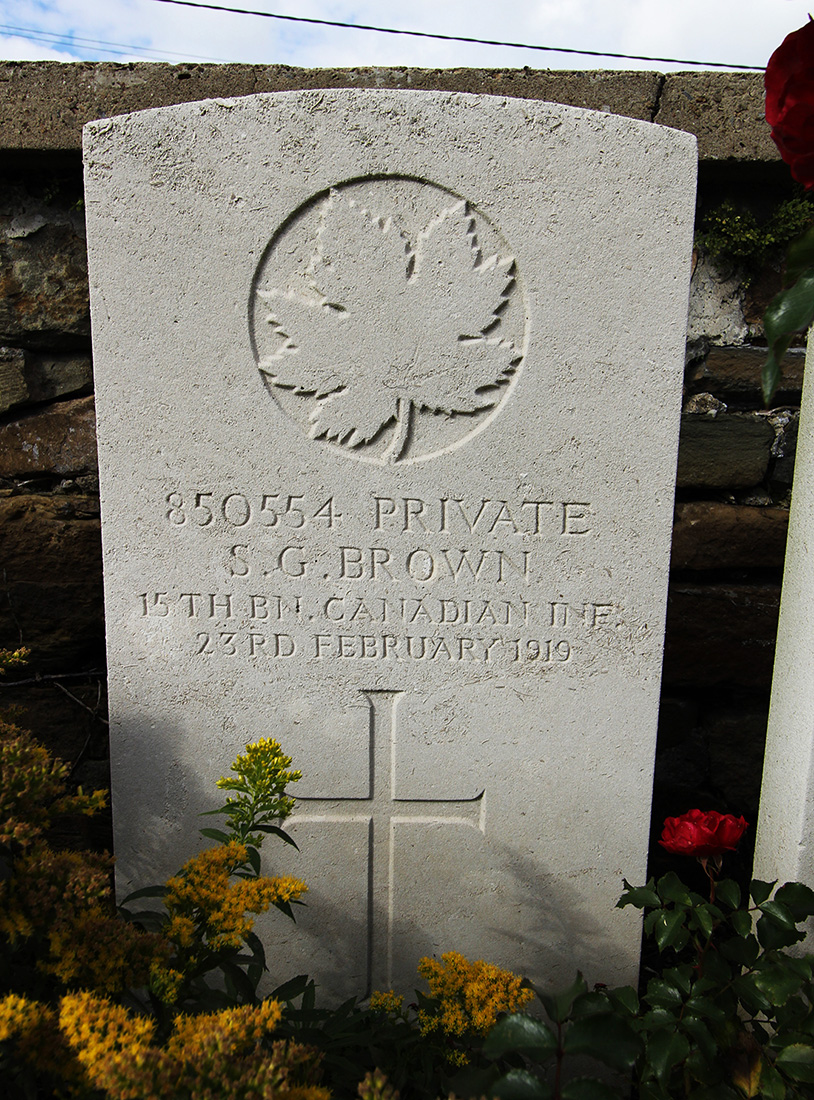
1889 - 1917
Died of the Spanish Flu in a hospital in Belgium, 23 Feb. 1919.
Age 29.
Stanley Brown lived in this with his brother Herman, and followed in his older brother's footsteps by enlisting in 1916. Sadly, just like his brother, he never returned home.
* * *
He enlisted there with the 2nd Dragoons, who were recruiting for the 176th Infantry Battalion, C.E.F., on April 29, 1916. Precisely one year later, he sailed with his unit to Liverpool aboard the S.S. Olympic, and was immediately transferred to the 12th Reserve Battalion. One month later, he was transferred to the 164th Infantry Battalion, and then again to the 5th Canadian Railway Troops (C.R.T.). It is with the 5th C.R.T. and with the rank of Sapper that he began his service at the front lines. Two years to the day of his enlistment, April 29, 1918, Stanley received a Good Conduct Badge.
His final transfer would come less than a month later, when on May 21 he was at last moved to the 15th Infantry Battalion, the same one in which his younger brother Herman had briefly served. Following a successful assault on Cambrai, the 15th Battalion were among the Canadian troops applying pressure to the Germans defending the Hindenburg line. On October 10, Stanley was wounded in the back by gunfire, and was moved to the 23rd Casualty Clearing Station in Brebières. He survived his wounding, and was moved to other field hospitals as he healed.
On February 21, 1919 Stanley was declared “Dangerously Ill” with Influenza at the 50th Casualty Clearing Station in Huy, Belgium. A third wave of “Spanish” flu was sweeping through Belgium at the time and ultimately claimed the life of Stanley Gordon Brown who died of bronchial pneumonia at the age of 29. He is buried at the Huy La Sarte Communal Cemetery. His mother Letitia, would light the lantern at the official unveiling of the Aurora War Memorial in October, 1925 in honour of the two sons that she lost in the war.
Read More: 176th CEF Battalion, (Niagara Rangers): https://www.niagarafallsreview.ca/news/niagara-region/2016/09/16/niagara-note-the-176th-served-its-country-well.html
5. Private Elwood Gardiner Lloyd
Aurora Museum & Archives (2002.19.862a)
1894 - 1916
Died of Wounds received at the Battle of the Somme, 29 Nov. 1916.
Age 22.
Elwood Gardiner Lloyd was born in Aurora in 1894, the eldest son of Seneca Doan Lloyd and Effie May Major. He attended classes at Aurora Public School on Church Street and Aurora High School on Wells Street, pictured here.
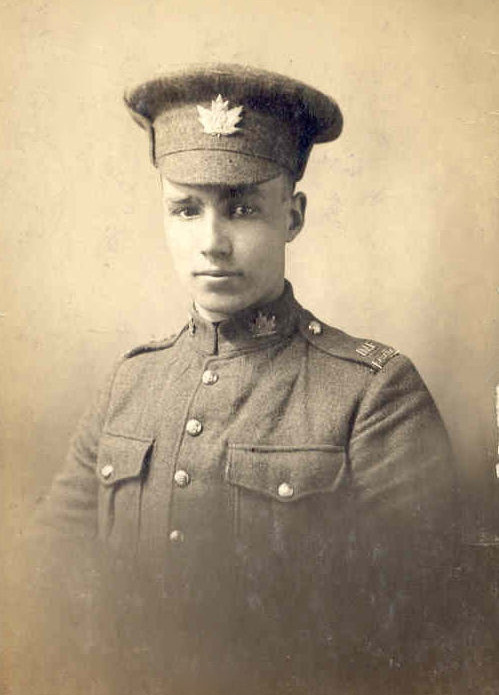
* * *
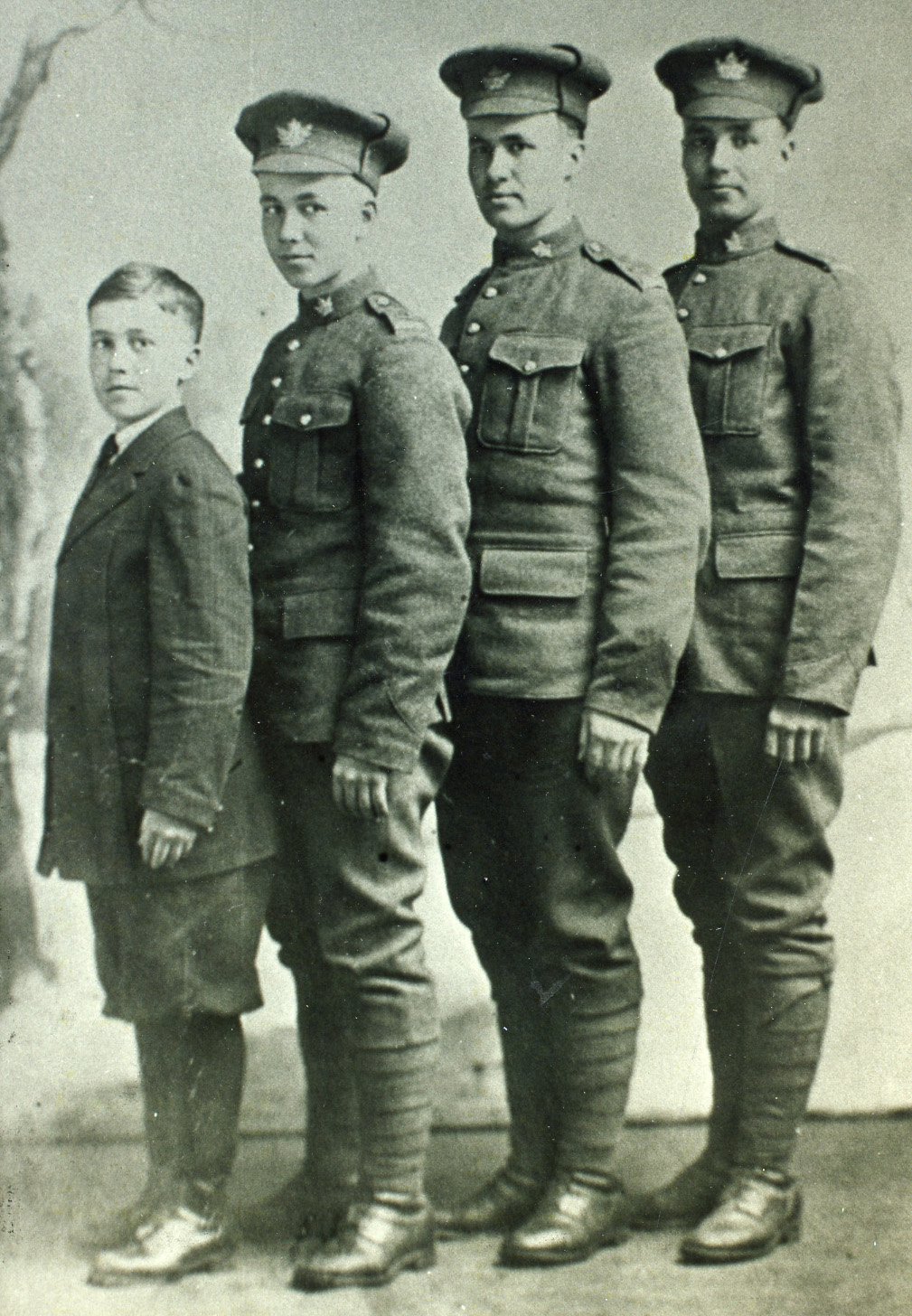
Elwood and his brothers, from left to right: Howard, Percy, Roscoe and Elwood. Howard didn't enter the service.
Upon arrival in France, Elwood was transferred to the 52nd Infantry Battalion, and was at the front lines on June 12, 1916, during the Battle of Mount Sorrel. He survived being plunged into the heart of combat, and fought through a bout of influenza in September.
On October 10, 1916, the 52nd Battalion was ordered to move from Chalk Pit Valley east to Tara Hill, an area that had been dearly won by the Canadians and British earlier that year. Sometime during the move, Elwood received a serious gunshot wound to the top of his head, and was brought to the No. 3 Stationary Hospital in Rouen, over 150km away.
By October 17, he was at Beaufort War Hospital in England, and was conscious and able to communicate in some fashion with the medical team. His father Seneca Lloyd received two cablegrams that month informing him that both Percy and Elwood had been injured at the front. While Percy would recover after receiving a gunshot wound to the left arm, Elwood was not so lucky. On November 4, his condition was listed as critical, but he held on until November 29, 1916 when he finally succumbed to his wounds. He was 22 years old.
Elwood is buried at the Bristol Cemetery in Gloucestershire, England.
Read More: Battle of the Somme: https://www.thecanadianencyclopedia.ca/en/article/battle-of-the-somme
52nd CEF Battalion (New Ontario): https://tbayworldwarone.com/2017/01/30/52nd-battalion-c-e-f
6. Sapper Charles Wesley Smith
Aurora Museum & Archives 994.35.54
1891 - 1918
Died in Hospital in England, 16 Feb. 1918.
Age 26.
Charles Wesley Smith was born in Zephyr, Ontario, in 1891 to Charles Smith and Harriet Reid. At the time of his enlistment, he had just married Matilda Annie Ferris two months previously and was living and working in Aurora as a Shoemaker. Charles had been part of the 12th York Rangers based out of the Armoury at Town Park and enlisted there in the rank of Private with the 127th Battalion, C.E.F. on December 20, 1915.
* * *
Charles began suffering abdominal pain in the summer of 1917. While on leave from France in December 1917, his condition worsened and he was admitted to the Bramshott Hospital in England January 23, 1918 where he underwent a series of operations. Charles was listed as “Seriously ill” and died of complications from appendicitis on February 16, 1918. He was 26 years old. Charles Wesley Smith is buried in the Bramshott Churchyard, England.
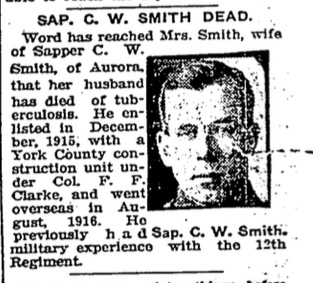
Obituary of Charles Wesley Smith.
Read More: 127 Battalion, CEF (York Rangers): http://www.rcl375.ca/battalion
7. Corporal Henry Harold Allen
Aurora Museum & Archives 81.65.85
1879 - 1916
Died of medical complications in England, 15 Sept. 1916.
Age 36.
This is St. Andrew's Presbyterian Church, where Allen was a minister before the war.
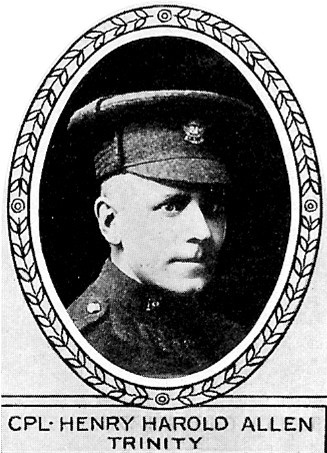
* * *
His unit sailed to Liverpool aboard the S.S. Olympic on April 28, 1916 and settled into training at West Sandling Transit camp in Kent. On June 10, Henry was appointed as Acting Corporal in his battalion. On the morning of his death it was reported that he was feeling ill and went into his tent after parade. Shortly thereafter, tragedy befell, and Henry went into a coma after accidentally ingesting what may have been medicine for the unit’s horses. He died at Shorncliffe hospital on June 15, 1916, and is buried at the on-site cemetery. Henry was 36 years old.
Read More: 81st Battalion, CEF: https://18thbattalioncef.blog/tag/81st-battalion/
8. Private Fred Luxon
1893 - 1917
Killed in Action at the Battle of Vimy Ridge, 9 April 1917.
Age 24.
Fred Luxon was born in 1893 in Devon, England to Richard and Amelia Luxon. Fred came to Canada as a young man in 1913. At the time of his enlistment, he was working in Aurora with J. Fleury’s Sons, and was a member of the Methodist Sunday School Orchestra, the Next to Nothing Methodist Sunday School Class and the Aurora Citizen’s Band. The Methodist Church he attended is pictured here, though the original building burned down in 2014.
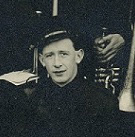
* * *
The 75th, despite being reduced in numbers in the weeks leading to the assault on Vimy Ridge, participated in the main push on April 9, 1917. It was during that operation that Fred Luxon was killed in action alongside over 100 other men in his battalion. He was 24 years old.
Tragically, Roy Hollingshead was also killed that day. Both had trained together in Aurora before heading overseas. It is perhaps owing to the fact Fred’s family was not from Aurora that his name was unfortunately misspelled as “Luxton” on the Aurora War Memorial and the street that bears his name. Fred is buried at the Canadian Cemetery in Neuville-St.Vaast.
Read More: Battle of Vimy Ridge: https://www.thecanadianencyclopedia.ca/en/article/vimy-ridge
75 Battalion, CEF (Mississauga): https://www.canada.ca/content/dam/themes/defence/caf/militaryhistory/dhh/documents/lineages/tsr.pdf
9. Private Roy Hollingshead
Aurora Museum & Archives 63.9.23
1892 - 1917
Killed in Action at the Battle of Vimy Ridge, 9 April 1917.
Age 25.
A view towards the Collis Leather plant that once stood on this spot. Roy Hollingshead worked here before he went overseas.
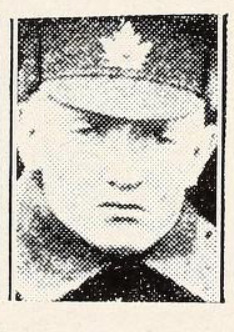
* * *
An article in the Aurora Banner, published on December 10, stated that the Home Guard were happy to report that Roy was one of five members of the Guard to report for active service. Fred Wilkinson was also part of that group. At the time of his enlistment, he was living in Aurora and working at the Collis Leather plant on Tyler Street.
On November 8, 1915, Roy enlisted with the Queen’s Own Rifles of Canada for the 95th Overseas Battalion, C.E.F., and sailed with his unit aboard the S.S. Olympic on May 31, 1916. He was transferred to the 3rd Infantry Battalion on September 16, 1916, and was on the front lines by October 4, during the Battle of Ancre Heights. His unit saw action at The Somme, Arras, and Vimy Ridge, where Roy was killed in action on April 9, 1917. He was 25 years old.
Tragically, Fred Luxon was also killed that day. Both had trained together in Aurora before heading overseas. Roy is buried at Ecoivres Military Cemetery, Mont-St. Eloi, France.
Read More:
Battle of Vimy Ridge: https://www.thecanadianencyclopedia.ca/en/article/vimy-ridge
95 Battalion, CEF: https://qormuseum.org
10. Sapper Walter Harris
Aurora Museum & Archives 994.3.2
1889 - 1917
Killed in Action at the Battle of Drocourt-Quéant Line, 20 April 1917.
Age 27.
Walter Harris once worked as a labourer here at J. Fleury's Sons, the renowned plow manufacturer. In 1915 he heard the call and enlisted, leaving behind his wife, Amy, and a young son.
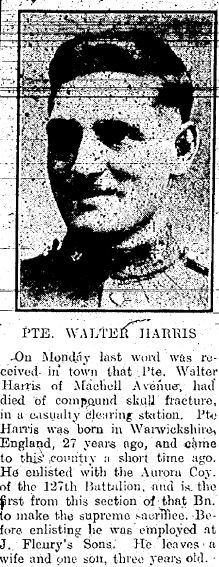
* * *
He was working as a Moulder at J.Fleury’s Sons on Wellington Street which is where Walter was able to find employment as a Labourer. At the outbreak of the war Walter and Amy were living on Machell Avenue with their young son Walter Frederick. Walter Sr. had been serving alongside his brother in law Heber Higgs in the Active Militia with the 12th York Rangers based out of the Armoury in Town Park.
Both men enlisted with the 127th Battalion, C.E.F. in Aurora on December 20, 1915. The two men sailed with the 127th to Liverpool aboard the S.S. Olympic on August 24, 1916. Walter remained stationed with the 127th , and arrived in France on January 13, 1917. Within a month his unit was re-designated as the 2nd Canadian Railway Troops, tasked with the construction and maintenance of several grades of track across the battle zone. At that time, Walter’s rank was changed to Sapper, the engineering equivalent of Private.
On April 18, 1917, Walter was with a work party at Velu Station, east of Lubucquiere, France, when explosives planted in an underground tunnel by the Germans exploded, killing and wounding a number of men. Walter Harris was among the wounded, severely injured with a compound fracture to the base of his skull.
Two days later, on April 20, 1917 he died at the No. 3 Casualty Clearing Station at Grevillers. Walter was 27 years old. He was buried nearby at the Grevillers British Cemetery in Bapaume, France.
Read More:
Battle of Drocourt-Quéant Line: https://www.vimyfoundation.ca/battle-of-the-drocourt-queant-line
127 Battalion, CEF (York Rangers): http://www.rcl375.ca/battalion
11. Private Alfred Ernest Davis
Aurora Museum & Archives 81.65.95a
1890 - 1915
Killed in Action at the Battle of Givenchy, 16 June 1915.
Age 24.
Alfred Ernest “Ernie” Davis was born in 1890 in Aurora to Joseph and Zilpha Ann Freeland. He attended school in Aurora, worked as a Moulder at J. Fleury’s Sons, pictured here, and a member of the Independent Order of Odd Fellows. At the outbreak of war Ernie was working in Oakville with his brother in law William Whittaker Jr., who also enlisted.
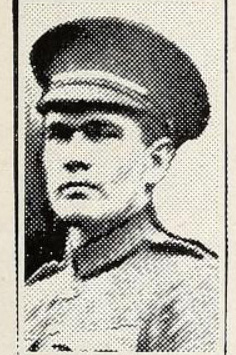
* * *
Near the end of the Second Battle of Ypres, on April 27, Ernie was wounded in the neck by gunfire while his battalion held a position at the junction of the Yser and Menin canals. The wound was not serious, and he was back with his unit within two weeks. It was just over a month later that he was reported missing when his Battalion was at Givenchy, a status which was later updated to Killed in Action.
Ernie was 24 years old. He has no known grave, and his name is inscribed on the Vimy Memorial.
Read More:
Battle of Givenchy: https://www.veterans.gc.ca/eng/remembrance/history/first-world-war/canada/Canada6
4th Battalion, CEF (Central Ontario): https://www.lornesmuseum.ca/page10/page14/page14.html
12. Gunner Robert Stuart Hillary
Aurora Museum & Archives 2002.19.434b
1896 - 1917
Died of Wounds received at the Battle of Vimy Ridge, 4 April 1917.
Age 20.
Robert Stuart Hillary, who went by Stuart, was born in 1896 in Aurora. He was the son of prominent local physician, and World War I medical officer, Major Robert M. Hillary and his wife Edith Howard Mussen. The family lived on Yonge Street in a home that they referred to as The Manor, now known as Hillary House. Stuart and his father Robert are pictured here.
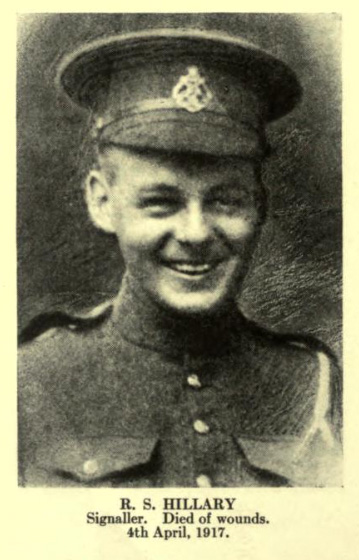
* * *
In the lead up to the Battle of Vimy Ridge on April 4, 1917, Stuart’s unit was moving between trenches near Neuville-St. Vaast when he was hit in the abdomen by machine gun fire. He was reported as “Dangerously Wounded” and taken to the No. 42 Casualty Clearing Station in Aubigny, France. Stuart Hillary died the same day of his wounds.
His mother received a telegram on April 7th advising her that her son had been wounded and a second telegram on April 10 th stating that he had died of those wounds. Stuart was 20 years old. He is buried in the Aubigny Communal Cemetery Extension.
Stuart’s younger sister Nora continued living in the family home on Yonge Street until 1992. The property was purchased by the Aurora Historical Society in 1981 who own and operate this Designated National Historic Site.
Read More:
Battle of Vimy Ridge: https://www.thecanadianencyclopedia.ca/en/article/vimy-ridge
2nd Regiment of the Royal Canadian Horse Artillery: http://www.2rcha.com/history.html
13. Major Kenneth Leon Taylor Campbell
Aurora Museum & Archives 83.62
1886 - 1917
Killed in Action at the Battle of Arras, 28 April 1917.
Age 30.
This photo shows a tea party in the backyard of Inglehurst, the opulent mansion built by J. Fleury that once stood on this spot. Kenneth Campbell lived here with his mother and attended Aurora High School on Wells Street.
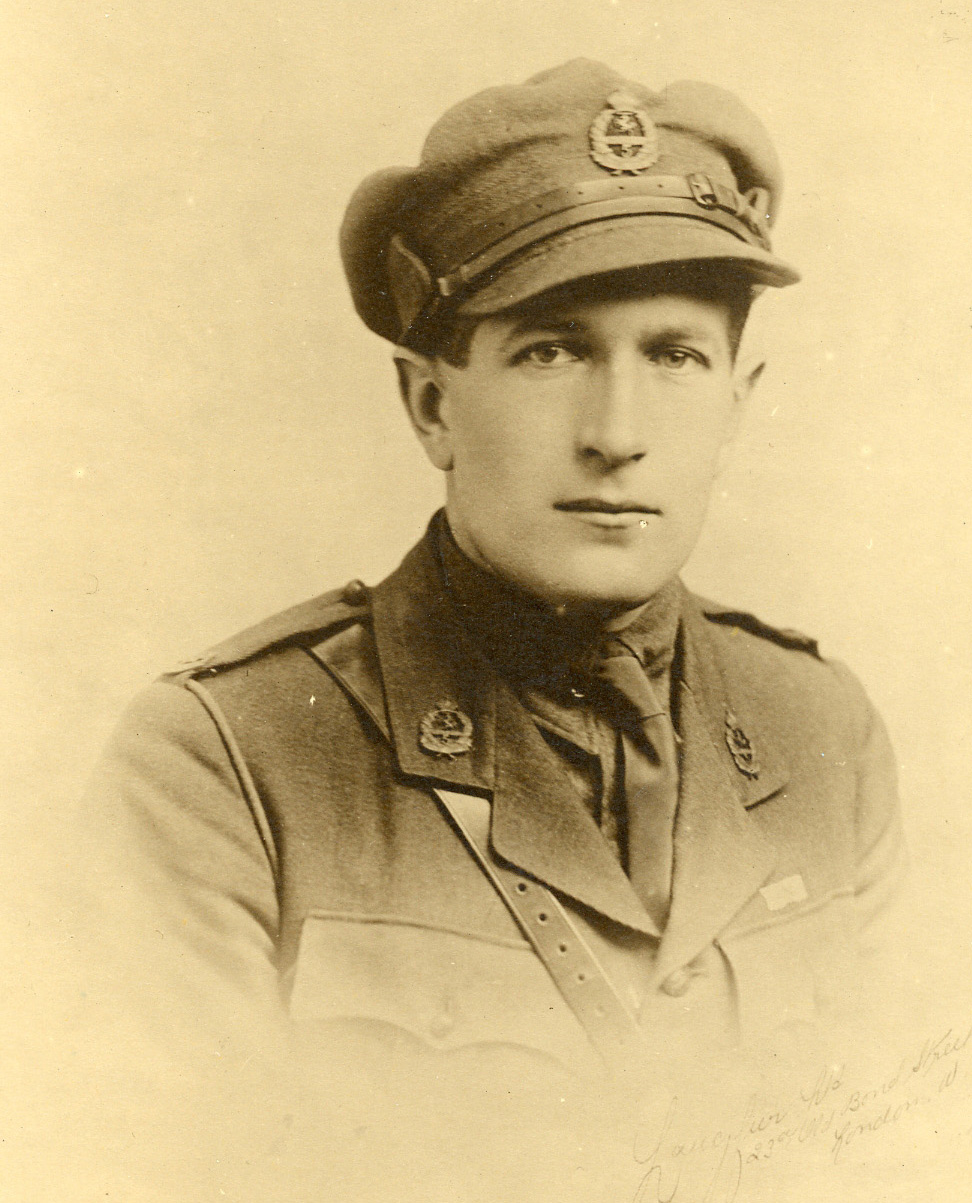
* * *
He was among those individuals eager to join the war very shortly after it had been declared, and traveled from Saskatchewan to Valcartier, Quebec, to enlist as a Private with the 5th Infantry Battalion, C.E.F. on September 21, 1914. Just four days later, he was promoted to Sergeant, and sailed with his unit aboard the S.S. Lapland on September 26. On February 15, 1915, he arrived with his unit in France. Kenneth was promoted to Company Sergeant-Major in May, and received a temporary commission to Lieutenant in October. In November and December, he was involved in action that resulted in him being awarded the Military Cross. The citation in the London Gazette for January 21, 1916 reads:
Lieutenant Kenneth Leon Taylor Campbell, 5th Canadian Infantry Battalion. For conspicuous gallantry on 15th December, 1915, during the attack on the advanced German barricade on the Messines road. Also for great gallantry in a previous attack on the German trenches at Hill 63 on 16th November, 1915.
During this time, he was injured twice but remained on duty, and was granted the rank of Acting Captain. Months later, on September 12, 1916, at the battle of The Somme, Kenneth was wounded by shrapnel in the right leg and left foot which saw him invalided to England for treatment. While he was away, his promotion to Captain proper was finalized, and following his convalescence, he rejoined the 5th Infantry Battalion on November 18, 1917. The next month, he was promoted to Acting Major.
Kenneth’s military career was one that had taken him from enlisted Private to Acting Major, and saw him recognized for his gallantry and devotion to duty. Tragically, on April 28, 1917, he was killed in action at the Battle of Arras and was buried at the Écoivres Military Cemetery in Mont-St. Eloi, France. Kenneth was 30 years old.
During the early 1920s, H.W. Fleury, a family relative, visited the allied cemeteries of France and brought back earth, a flower, and a photograph of Kenneth’s gravesite for his mother.
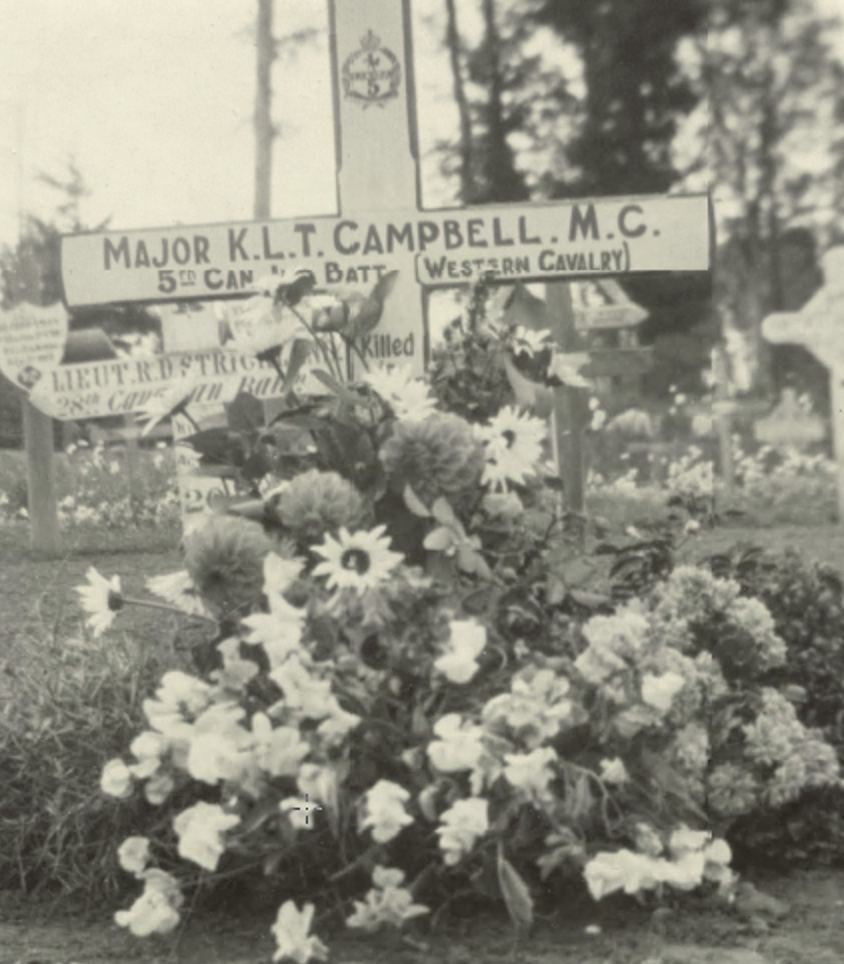
Photograph of Lt. Campbell's grave taken by H.W. Fleury just after the war.
Read More:
Battle of Arras: https://www.re-museum.co.uk/the-battle-of-arras-9-april-1917
5th Battalion, CEF (Western Cavalry): https://esask.uregina.ca/tmc_cms/modules/customcode/includes/print_entry.cfm-entryid=73419763-1560-95DA-438D7A895E0504A3.jsp
14. Private Edwin Harold Mulloy
Aurora Museum & Archives 79.1.53
1887 - 1915
Killed in Action at the Second Battle of Ypres, 22 April 1915.
Age 27.
Edwin Harold Mulloy was born in 1887 in Grimsby, Ontario to Charles Wesley Mulloy and Gertrude (Gitty) Claflin. He had a twin sister named Florence Silva. When his father, C.W. Mulloy, was appointed Principal of Aurora High School, the family moved to Aurora and resided on Wellington Street. Edwin attended Aurora High School, was a member of the local chapter of the Rising Sun Lodge and the Independent Order of Oddfellows. He also worked at the Bank of Montreal, pictured here, as a clerk.
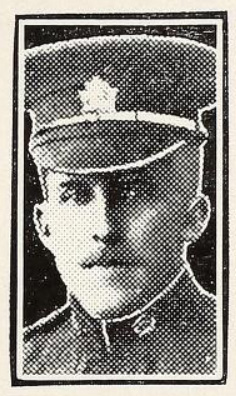
* * *
In March, Edwin wrote home letters to his mother which were published in the Aurora Banner, describing the conditions in the trenches and that he felt his position with the Battalion Staff would keep him away from most of the danger. On April 22, 1915, the 3rd Battalion was ordered to march from Vlamertinge to Brielen, just 2.5km away. Once there, they dug in to camp for the night, half the unit close to the road, the other half in the field nearby. At 1:15am on April 23, 1915, an enemy shell exploded in the camp on the road, killing 5 men outright and wounding 3 more. Sgt. Edwin Harold Mulloy was among the men killed. He was 27 years old.
Edwin is commemorated on the Menin Gate Memorial, a monument for soldiers whose graves are not known, in Ypres, Belgium. He was the first soldier from Aurora to die in the war, and flags were flown at half-mast in the town in his honour.
Read More:
Second Battle of Ypres: https://www.warmuseum.ca/firstworldwar/history/battles-and-fighting/land-battles/second-ypres
3rd Battalion, CEF (Toronto): https://qormuseum.org/history/timeline-1900-1924/the-first-world-war/perpetuated-battalions/3rd-toronto-battalion-canadian-expeditionary-force/
15. Private Frederick H.B. Wilkinson
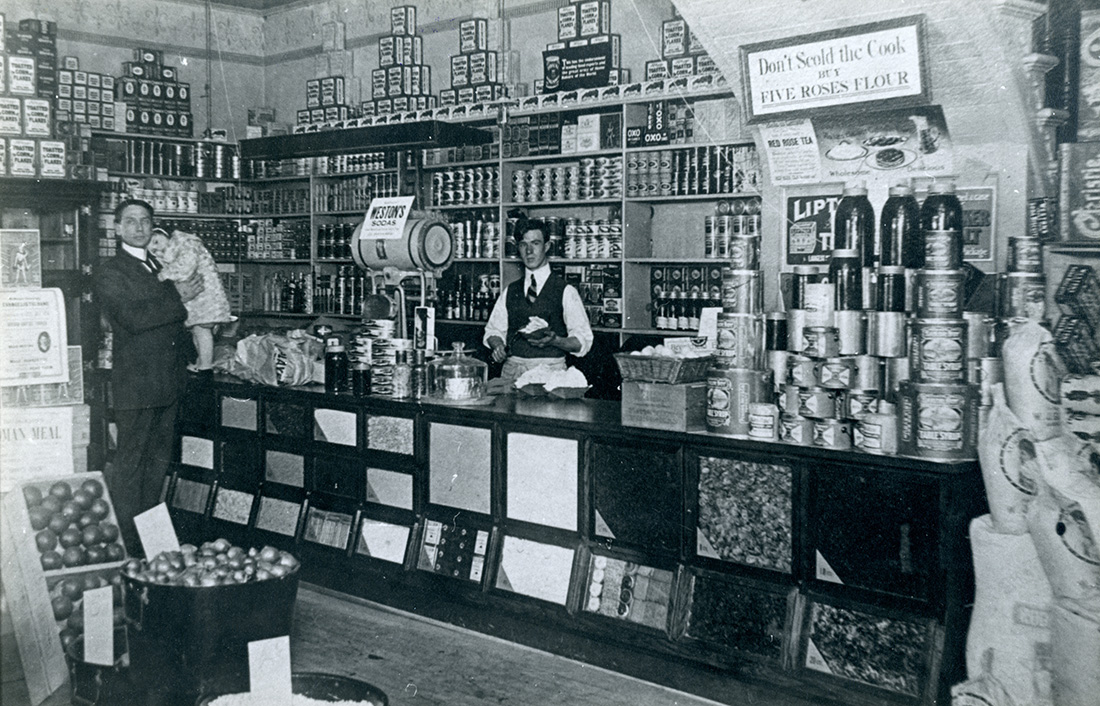
Aurora Museum & Archives 2002.19.66
1898 - 1916
Killed in Action at the Battle of the Somme, 21 Aug. 1916.
Age 18.
Fred Hosea Barton Wilkinson was born in Markham, Ontario in 1898 to George Wilkinson and Emily Rutter. After his family moved to Aurora, Fred became a member of the Next to Nothing Sunday School Class at the Methodist Sunday School. He was also one of the three young men in town who joined the Girls Red Cross Auxiliary immediately after it was formed. At the time of his enlistment, Fred was living with his family on Machell Street and working as a salesman in the grocery department of Whimster & Company. The photo above shows the store where he worked, taken about 1910.
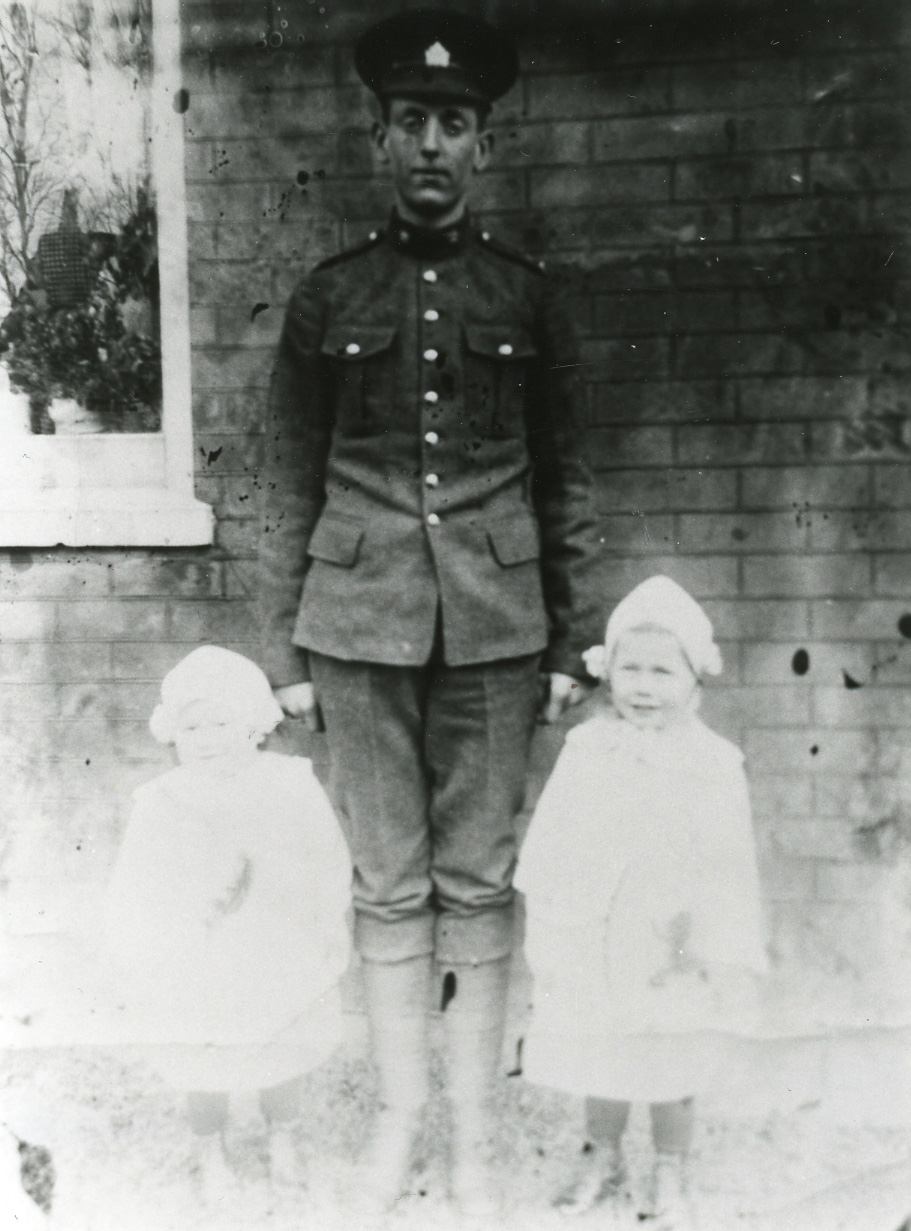
Frederick Wilkinson and his siblings.
* * *
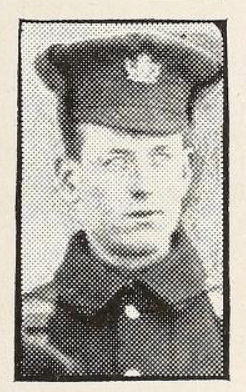
Fred’s obituary in the local paper characterized him as “a general favorite with his companions and was most highly thought of by all people who knew him”.1 He is commemorated on the Menin Gate Memorial, a monument for soldiers whose graves are not known, in Ypres, Belgium.
Read More:
Second Battle of Ypres: https://www.warmuseum.ca/firstworldwar/history/battles-and-fighting/land-battles/second-ypres
43rd Battalion, CEF (The Queen's Own Cameron Highlanders of Canada): https://thequeensowncameronhighlandersofcanada.net/regiment/the_great_war.html
16. Private Walter Kenneth Exley
Aurora Museum & Archives 988.50.34
1896 - 1916
Killed in Action at the Battle of Coucelette, 18 Nov. 1916.
Age 19.
Walter Kenneth Exley was born in Victoria, B.C. in 1897 to Frederick T. Exley and Lillian Gertrude Fillmore. At the outbreak of war, he was employed by the Imperial Bank, and worked as a clerk at the branch on Yonge Street, which once stood on this spot.
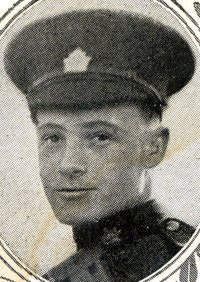
* * *
He sailed with his unit to Liverpool aboard the S.S. Olympic on April 28 of the same year. After a summer of training and preparation, during which he was transferred to the 74th then 87th Infantry Battalions, then the 11th Trench Mortar Battery, and finally to the 75th Infantry, Walter was in France on August 12, 1916. The 75th was fully engaged in the bloody Battle of the Somme, and were instrumental in the taking of Desire Trench near Courcelette, the final objective of the battle. During this charge, on November 18, 1916, Walter Exley was reported missing, his status updated to Killed in Action the next month. He was 19 years old.
Walter was buried at the Serre Road Cemetery No.1, to the northeast of Courcelette in France. He may have used his middle name as he is listed as Kenneth W. Exley in Aurora’s Honour Roll published in the Aurora Banner during the war.
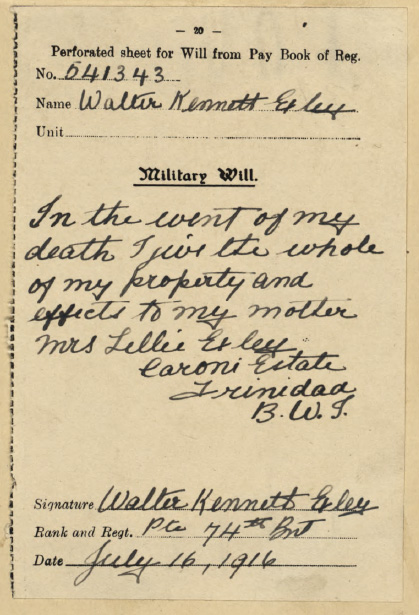
Pvt. Exley's last will and testament, written before going into action at the Somme.
Read More:
Battle of Courcelette: https://www.thecanadianencyclopedia.ca/en/article/battle-of-courcelette
75th Battalion, CEF (Toronto Scottish): https://www.scribd.com/book/364734200/Toronto-s-Fighting-75th-in-the-Great-War-1915-1919-A-Prehistory-of-the-Toronto-Scottish-Regiment-Queen-Elizabeth-The-Queen-Mother-s-Own
17. Private Henry (Harry) Stone
Aurora Museum & Archives 2005.28.95k
1863 - 1916
Died in hospital in England, 3 Nov. 1916.
Age 53.
Henry (Harry) Stone was born in Berkshire, England in 1863. He served in the Imperial Army in the 1880s in Egypt, earning the Khedive’s Star and the Egypt medal. After immigrating to Canada, he served with the 12th York Rangers, based at the Armoury in Town Park. At the outbreak of the war, Henry was living in Newmarket with his wife Jane Stone and family and working for the Metropolitan Railway. Pictured above is Aurora's Metropolitan Station, which Stone would have frequented.
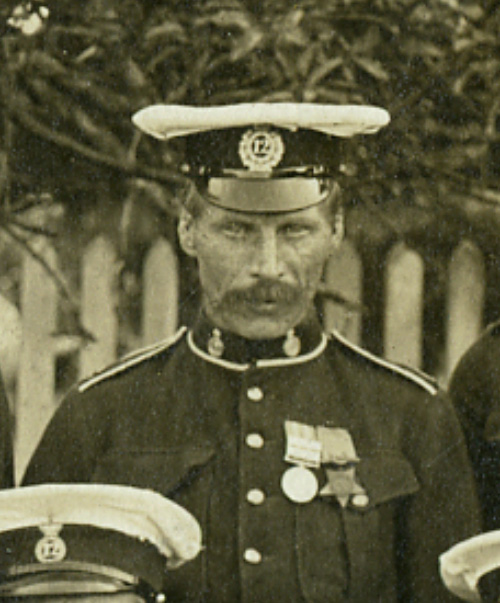
* * *
As reported by Major Hillary to the Aurora Banner (November 24, 1916), Henry was buried at the nearby Aldershot Military Cemetery among the most decorated soldiers’ graves, following a mile- long procession to honour the old soldier. His son Harry was in attendance, as well as an old comrade from his days serving in Egypt who led the procession.
Read More:
127th Battalion, CEF (12th York Rangers): http://www.kinglibrary.ca/WW1Letters/127th%2001.php
18. Major Wilfred Ferrier Petermann
Aurora Museum & Archives 74.4.1
1888 - 1916
Killed in Action at the Battle of the Somme, 26 Sept. 1916.
Age 28.
Wilfred F. Petermann was born in 1888 in Aurora to Jacob Petermann and Margaret Ferrier and grew up living on Yonge St. near the corner of Church St. At the time of his enlistment, Wilfred was living with his wife Mary Johnston and young daughter Marguerite in Cobalt, Ontario where he was working as a customs officer.
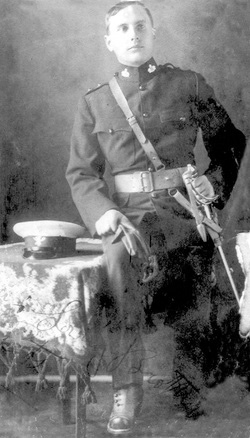
* * *
In February of 1916, he suffered from Influenza, and was away from his unit for over a month. On April 19, he was in a signal dugout when a shell exploded above his position. Two signalers were killed outright by the blast, and Wilfred was buried in the rubble. He remained conscious despite a forehead wound, significant bruising, and having broken two teeth. Wilfred was treated at the No. 7 Stationary Hospital in Boulogne, and transferred to Guy’s Hospital in London, and again to the Queen Alexandra Military Hospital, where he recovered fully. Exactly one month after the blast, on May 19, Wilfred was back with his Battalion.
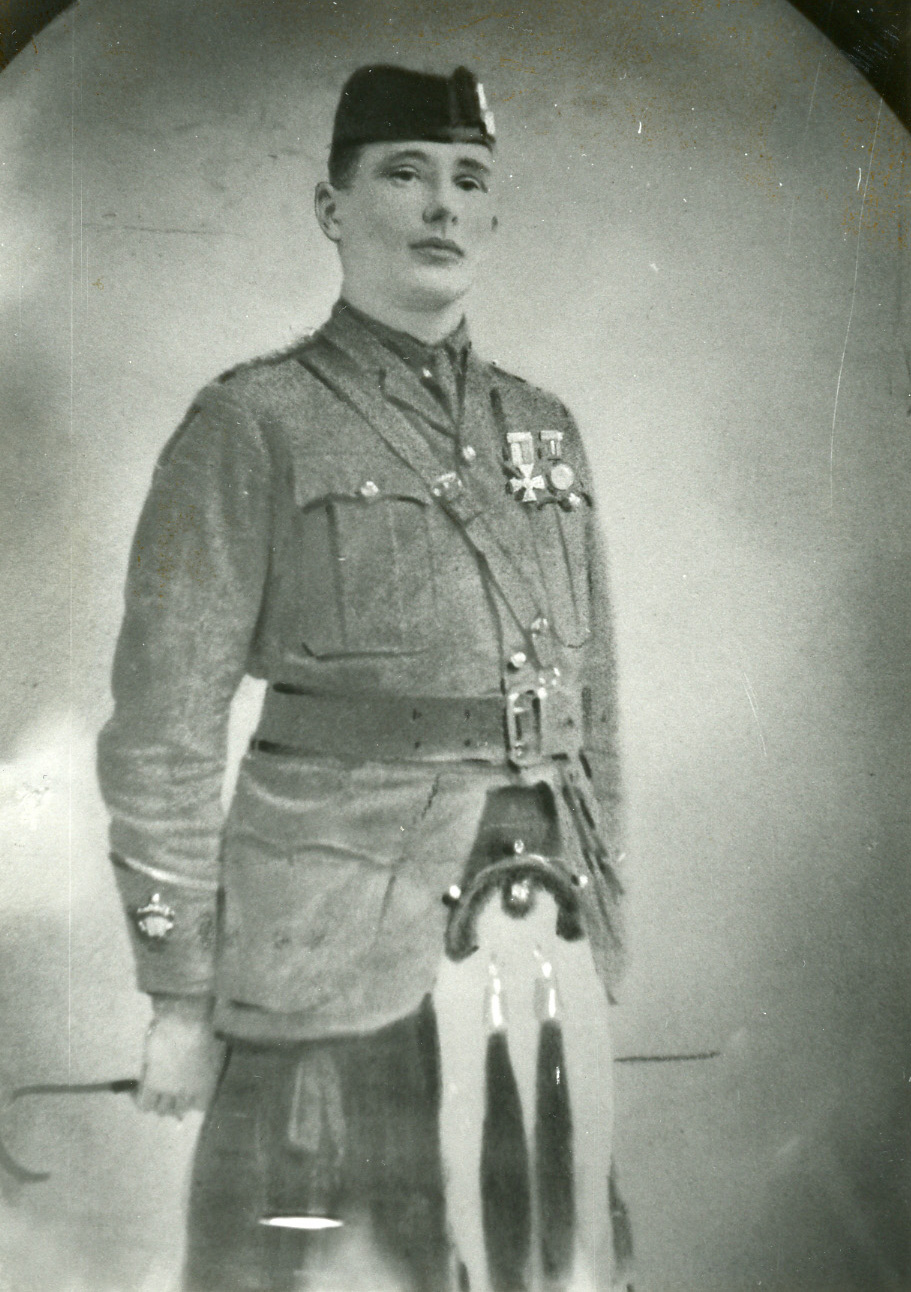
Major Petermann in the dress uniform of the 13th Battalion, the Royal Highlanders of Canada.
On June 13, he suffered a second injury as an enemy grenade exploded and struck him in the helmet. He was again treated in Boulogne and when his perforated eardrum became problematic, he was again transferred to Queen Alexandra in England. Finally healed and once again back with his unit on July 23, 1916, he was promoted to Acting Major, to be given command of a company when required. This responsibility came to pass on September 3, 1916 when he commanded No. 3 Company, the Machine Gun Section, which supported an advance that saw over 300 casualties from the Battalion.
On the 26th of that month, Major Wilfred Petermann was Acting Second-in-Command at the Battalion’s Headquarters, along with the Officer in Command (O.C.) and a number of other officers and soldiers, when a shell exploded and set off a secondary gasoline explosion. Twelve men were killed immediately, including the O.C., and Wilfred, with over 30 more men suffering burns and wounds. Wilfred was 28 years old.
He is buried at the nearby Albert Cemetery Extension and his name also appears on the war memorial in Cobalt, Ontario.
Read More: Battle of the Somme: https://www.thecanadianencyclopedia.ca/en/article/battle-of-the-somme
13th Battalion, CEF (Royal Highlanders of Canada): http://www.canadiangreatwarproject.com/writing/13th.htm
19. Private Thomas Crosskill
Aurora Museum & Archives 2002.19.98
1890 - 1918
Killed in Action at the Battle of Arras, 23 April 1918.
Age 27.
When Thomas Crosskill went off to war in 1915, he left behind his job at the T. Sisman Shoe Co. and his friends in the Oddfellows Order. He was evidently well-liked in the community, and a farewell party for him and two other men was held at the town's arena, which once stood on this spot. It must have been a jubilant occasion, for the long casualty lists would not have begun arriving yet. The arena itself collapsed under heavy snowfall in 1927.
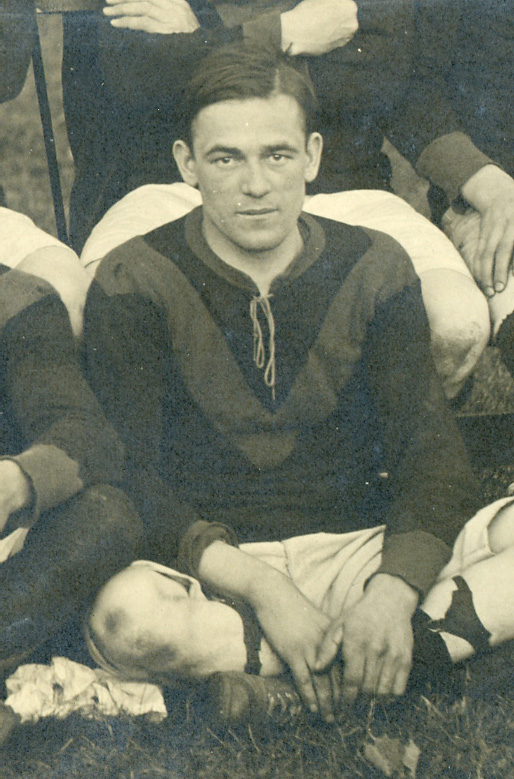
Thomas Crosskill with the Aurora Football Club in 1914.
* * *
At the time of his enlistment, he was employed by the T. Sisman Shoe Co. in Aurora. Thomas must have made a good impression, as the Town hosted a farewell party in February, 1915, for him and two other soldiers presenting each with a purse containing $20.00. Thomas was given an additional purse of $15.00 by the Oddfellows Order, of which he was a member.
His unit sailed to Liverpool aboard the S.S. Megantic on May 15, 1915. While overseas Thomas wrote several letters which were published in the Aurora Banner. Before and after his Battalion sailed to France on September 14, 1915, medical problems had arisen. He had a persistent ear infection that saw him invalided back to England on February 11, 1916. He was in and out of the hospitals in England and was transferred between various service and casualty units, before finally being reunited with the 20th Battalion on December 3, 1917, while they were training with Lewis Light Machine Guns at Neuville-St.Vaast. Thomas had one further bout of his persistent ear infection, and was in hospital March 13-25.
On April 23, 1918, at Neuville Vitasse, Thomas Crosskill was killed in action. He was 27 years old. Thomas was buried at the nearby Wailly Orchard Cemetery in France.

Read More:
Battle of Arras: https://www.re-museum.co.uk/the-battle-of-arras-9-april-1917
20th Battalion, CEF (Central Ontario): http://contentdm.ucalgary.ca/digital/collection/cmh/id/72668/
20. Private Ernest Rose
Aurora Museum & Archives 988.39.4
1889 - 1918
Killed in Action at the Battle of the Scarpe, 31 July 1916.
Age 29.
Ernest Rose was born in 1889 to Andrew Rose and Maria Fairbairn of Aurora. At the time of his enlistment, he was working as a Farmer and his family lived at this location, 137 Yonge Street (later renumbered 14993 Yonge Street). The photo above shows his mother with three of her children.
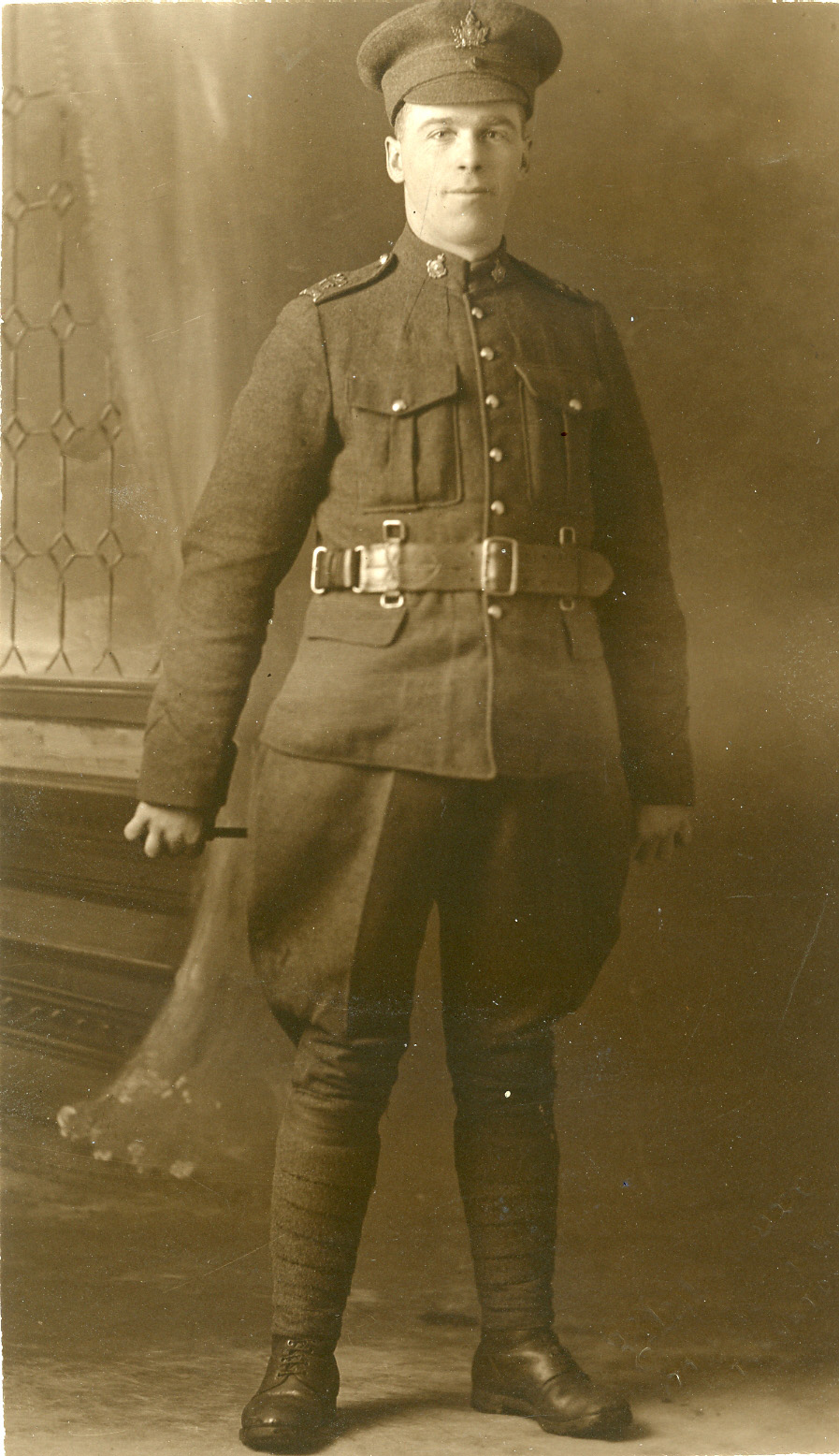
* * *
Ernest was not long with his new battalion when, during what would later be called The Battle of Scarpe, his unit was occupying a forward position South-East of Cherisy. The trenches there were made up mostly of shell holes with poor cover from German fire.
On August 29, 1918, Ernest Rose was one of three soldiers instantly killed at this location when a shell exploded directly beside him in his trench. He was 29 years old, and was buried at the Achicourt Road Cemetery in France.
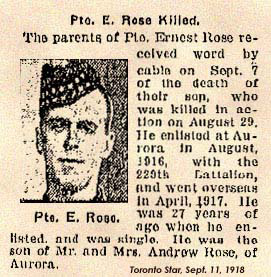
During the early 1920s, Aurora local H.W. Fleury visited the allied cemeteries of France and brought back earth, a flower and a photograph of Ernest’s gravesite for his parents.
Read More:
Battle of the Scarpe: https://www.canada.ca/en/department-national-defence/services/military-history/history-heritage/battle-honours-honorary-distinctions/scarpe-1917.html
15th Battalion, CEF (48th Highlanders of Canada): http://15thbattalioncef.ca/regimental-history/
21. Private Stewart William Stiles
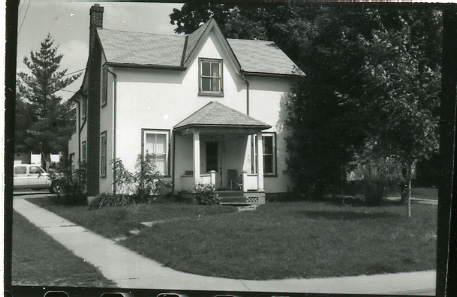
1897 - 1918
Killed in Action at the Battle of the Drocourt-Queant Line, 2 Sept. 1918.
Age 21.
Stewart William Stiles was born in Newmarket in 1897 to David Stiles and Hannah Lloyd. At the time of his enlistment, he had been living just a short time in Aurora, and working as a Shoemaker at the T. Sisman Shoe Company. Stewart's parents were living in this home when they received the utterly devastating news that their son had fallen in battle.
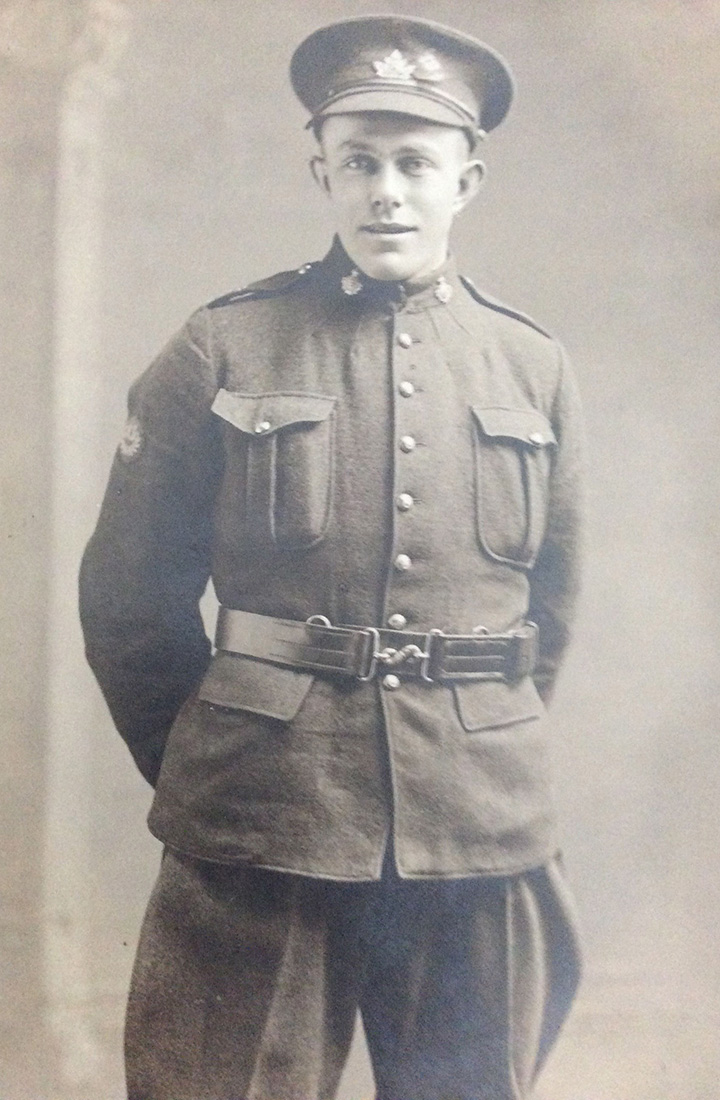
* * *
Stewart was with the “Fighting 75th” for the instrumental Battles of Amiens and Scarpe, the launching point for the Hundred Days Offensive, and served at times as a Machine Gun instructor. When it was finally time to push the Germans from the Drocourt-Quéant Line, there was a tremendous push by Canadian and British forces. September 2, 1918, saw over 60 men of the 75th Battalion killed in action, with hundreds wounded. Stewart Stiles was among those killed in action that day. He was 21 years of age.
His parents were living at 21 Gurnett Street when they learned of his death. Stewart is buried at Dury Mill British Cemetery, Pas de Calais, France.
Read More:
Battle of Drocourt-Quéant Line: https://www.vimyfoundation.ca/battle-of-the-drocourt-queant-line
75th Battalion, CEF (Toronto Scottish): https://www.scribd.com/book/364734200/Toronto-s-Fighting-75th-in-the-Great-War-1915-1919-A-Prehistory-of-the-Toronto-Scottish-Regiment-Queen-Elizabeth-The-Queen-Mother-s-Own
22. Private James Albert Proctor
1898 - 1917
Killed in Action at the Battle of Arras, 9 May 1917.
Age 18.
James Albert Proctor, known to his friends as “Chappie,” was born in Aurora in 1898 to Simon Albert, a horseman well known in Ontario, and Della (Minnie) Waite. For his elementary school, James attended Aurora Public School, located at 22 Church Street, and pictured here.
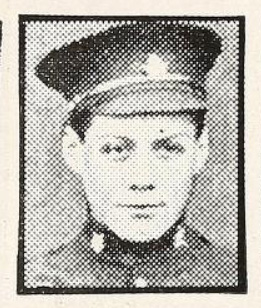
* * *
The 18th Battalion saw heavy combat during the war, and James was present for the Battles of the Somme, Flers-Courcelette, Ancre Heights, and Vimy Ridge. On May 9, 1917, James Albert Proctor was killed in the action surrounding the German re-taking of the town of Fresnoy. He was 18 years old. His grandparents, Mr. & Mrs. James Waite, lived in Aurora at the time of his death. James is buried at the Orchard Dump Cemetery in Pas-de-Calais, France.
Read More:
Battle of Arras: https://www.re-museum.co.uk/the-battle-of-arras-9-april-1917
18th Battalion, CEF (Western Ontario): https://18thbattalioncef.blog/
23. Lieutenant Robert Ross Hartman
Aurora Museum & Archives 83.1.1
1887 - 1915
Killed in Action during the 100 Days Campaign, 2 Sept. 1918.
Age 31.
The war memorial is at Aurora's Peace Park. It is not officially part of this walking tour, however we encourage you to pay a visit to see the Cenotaph. You can reach it by walking past the old school and back on to Yonge Street. Then you turn left and continue south for about a ten minute walk.
Robert Ross Hartman, known as “Fat” by his friends, was born in Aurora in 1887, the son of Isaac Hartman and his wife Sarah Yetter Reifsnyder. Isaac had been a leading merchant in Aurora and the family lived for a time in Dawson City Yukon after Isaac was appointed as the Postmaster by Sir William Mulock in 1897. Sometime after the death of his mother in 1906, the family returned to Aurora and Robert attended classes at Upper Canada College.
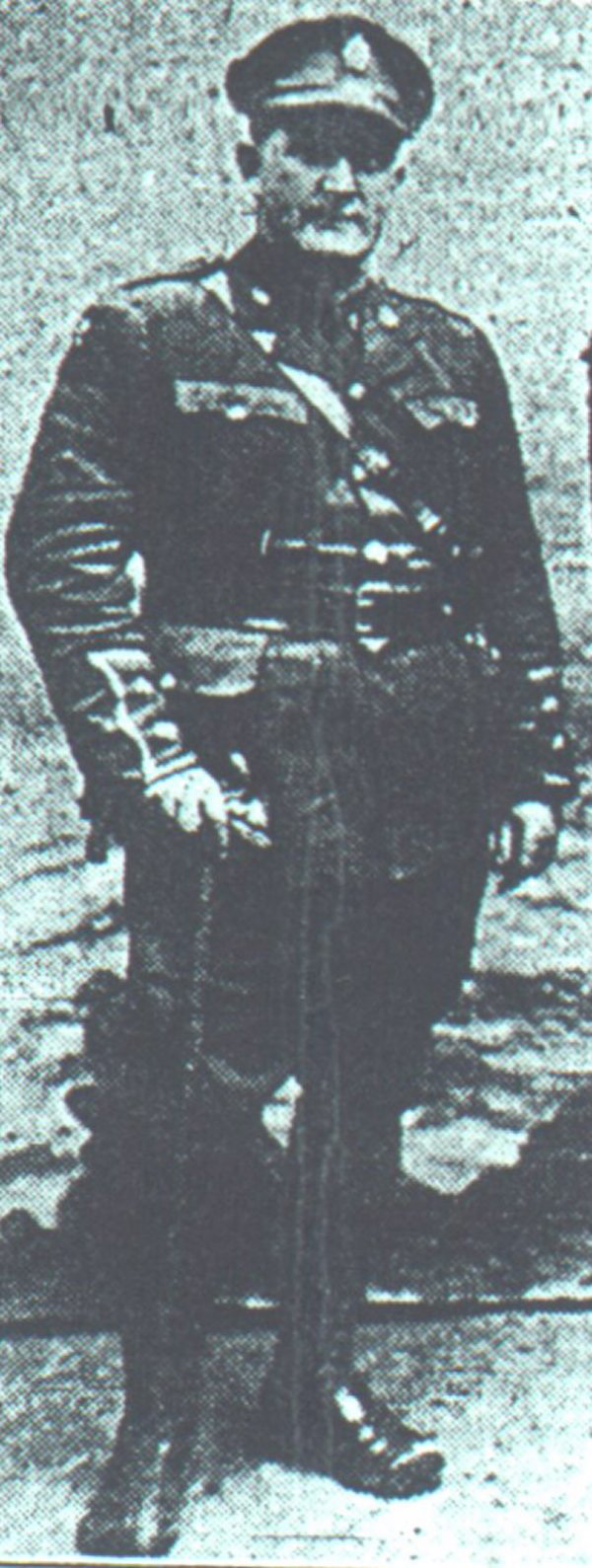
* * *
It was more than a year after enlisting that Robert’s battalion sailed to Liverpool, on April 11, 1917, aboard the H.M.S. Carpathia. Upon disembarking in Liverpool on April 22, the 227th was absorbed into the 8th Reserve Battalion. On September 4, 1917 the 8th Reserve fulfilled its role and was added to the 102nd Battalion, just before its departure for France.
Robert served with the 102nd for just two months when on November 10, he was attached to the 11th Canadian Trench Mortar Battery to fill a vacancy in their command.
On September 2, 1918, Robert Ross Hartman was killed by a shell explosion at Dury Hill, France. He was 31 years old. Robert was buried at Dury Mill British Cemetery, Pas de Calais, France.

Hartman's obituary.
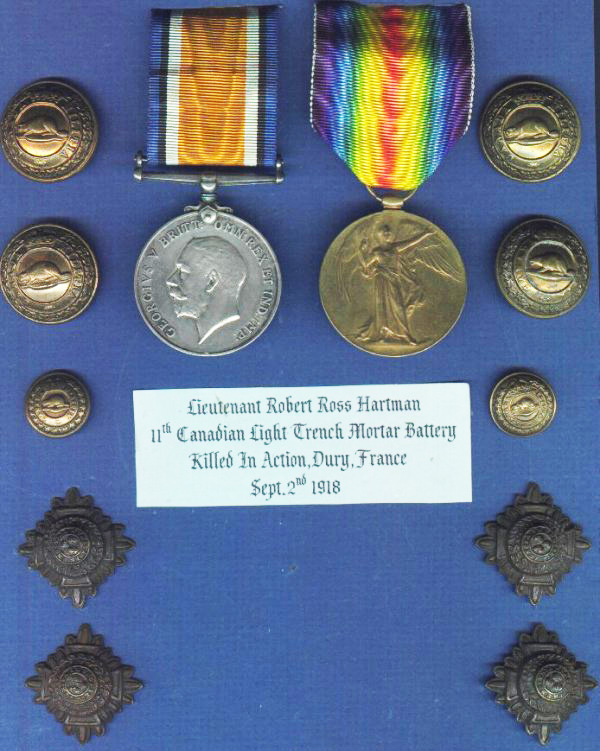
Medals and buttons belonging to Robert Ross Hartman.
Read More:
100 Days Campaign: https://www.canadashistory.ca/explore/military-war/the-great-war-hundred-days-campaign
102nd Battalion, CEF (Central Ontario): http://www.102ndbattalioncef.ca/
Endnotes
- 1. Aurora Banner, October 9, 1925.
1. Private James A Amos
Header image courtesy of Aurora Museum (988.6.1).
12th York Rangers image courtesy of Queen’s York Rangers Regimental Museum.
Gravesite image courtesy Veterans Affairs Canada.
2. Corporal Heber L. Higgs
Header image courtesy of Aurora Museum (81.65.98).
Newspaper image courtesy of Aurora Banner (November 16, 1917).
Gravesite image courtesy of findagrave.com.
3. Private Herman Clifton Brown
Header image courtesy of Aurora Museum & Archives.
Newspaper image courtesy of the Toronto Star.
Gravesite image courtesy of findagrave.com.
4. Private Stanley Gordon Brown
Header image courtesy of findagrave.com.
5. Private Elwood Gardiner Lloyd
Header image courtesy of Aurora Museum & Archives (2002.19.862a).
Portrait image courtesy of Veterans Affairs Canada.
Family portrait courtesy of Aurora Museum & Archives.
6. Sapper Charles Wesley Smith
Header image courtesy of Aurora Museum & Archives (994.35.54).
Image courtesy of Veterans Affairs Canada.
7. Corporal Henry Harold Allen
Header image courtesy of Aurora Museum & Archives (81.65.85).
Portrait image courtesy of Veterans Affairs Canada.
8. Private Fred Luxon
Header image courtesy of Aurora Museum.
Portrait photo courtesy of Aurora Museum & Archives (74.9.1).
9. Private Roy Hollingshead
Header image courtesy of Aurora Museum & Archives (63.9.23).
Portrait image courtesy of Veterans Affairs Canada.
10. Sapper Walter Harris
Header image courtesy of Aurora Museum & Archives (994.3.2).
Newspaper image courtesy of Aurora Banner, April 27, 1917.
11. Private Alfred Ernest Davis
Header image courtesy of Aurora Museum & Archives (81.65.95a).
Portrait image courtesy of Veterans Affairs Canada.
12. Gunner Robert Stuart Hillary
Header image courtesy of Aurora Museum & Archives (2002.19.434b).
Portrait image courtesy of Veterans Affairs Canada.
13. Major Kenneth Leon Taylor Campbell
Header image courtesy of Aurora Museum & Archives (83.62).
Portrait image courtesy of Aurora Museum & Archives.
Gravesite image courtesy of David Fleury.
14. Private Edwin Harold Mulloy
Header image courtesy of Aurora Museum & Archives (79.1.53).
Portrait courtesy of Veterans Affairs Canada.
15. Private Frederick H.B. Wilkinson
Header image courtesy of Aurora Museum & Archives (2002.19.66).
Family portrait courtesy of Aurora Museum & Archives (WW1 Records).
Portrait courtesy of Veterans Affairs Canada.
16. Private Walter Kenneth Exley
Header image courtesy of Aurora Museum & Archives (988.50.34).
Portrait image courtesy of Veterans Affairs Canada.
Last will and testament courtesy of CEF Records, RG 150, Accession 1992-93/166, Box 2967-7.
17. Private Henry (Harry) Stone
Header image courtesy of Aurora Museum & Archives (2005.28.95k).
Portrait courtesy of Queen's York Rangers Regimental Museum.
18. Major Wilfred Ferrier Petermann
Header image courtesy of Aurora Museum & Archives (74.4.1).
Portrait courtesy of Veterans Affairs Canada.
Dress Uniform portrait courtesy of Aurora Museum & Archives (WW1 Records).
19. Private Thomas Crosskill
Header image courtesy of Aurora Museum & Archives (2002.19.98).
Football club image courtesy of Aurora Museum & Archives 992.13.4.
Portrait image courtesy of Veterans Affairs Canada.
20. Private Ernest Rose
Header image courtesy of Aurora Museum & Archives (988.39.4).
Portrait courtesy of Aurora Museum & Archives (WW1 Records).
Newspaper courtesy of Veterans Affairs Canada.
21. Private Stewart William Stiles
Header image courtesy of Aurora Museum & Archives.
Portrait courtesy of Aurora Museum & Archives (WW1 Records).
22. Private James Albert Proctor
Header image courtesy of Bob McRoberts.
Portrait courtesy of Veterans Affairs Canada.
23. Lieutenant Robert Ross Hartman
Header image courtesy of Aurora Museum & Archives (83.1.1).
Portrait Image courtesy of Veterans Affairs Canada.
Obituary courtesy of Veterans Affairs Canada.
Medals and buttons courtesy of Veterans Affairs Canada.





